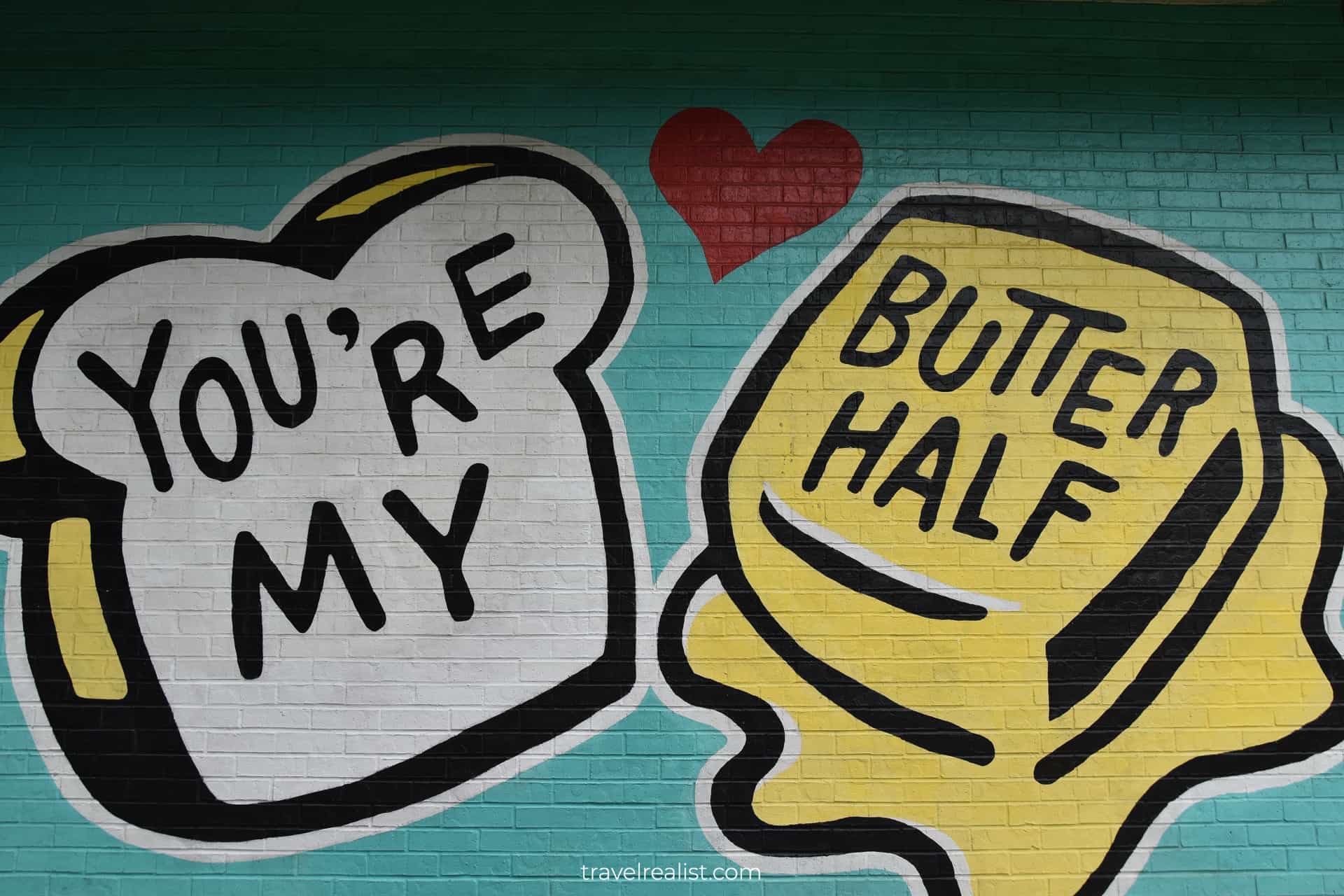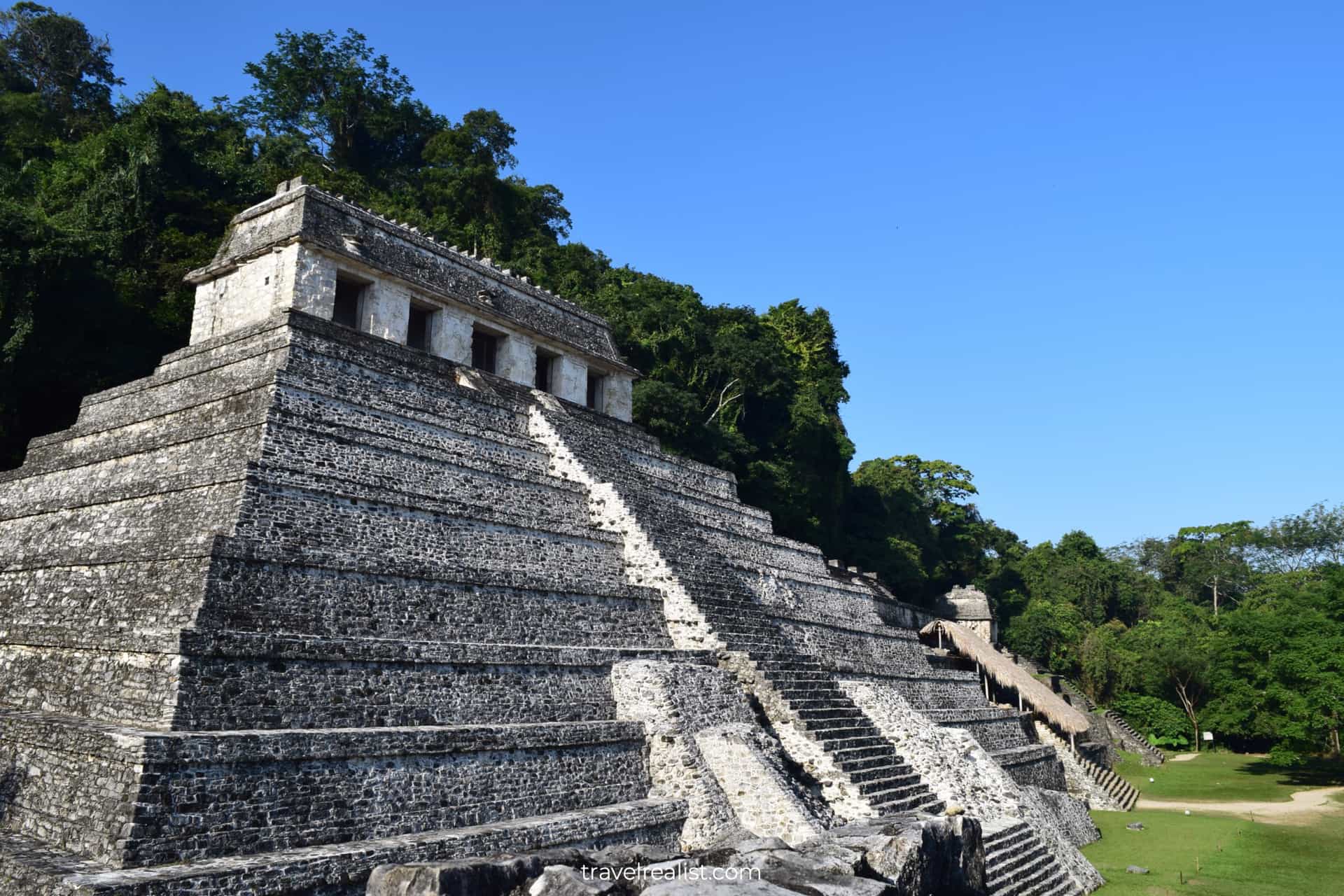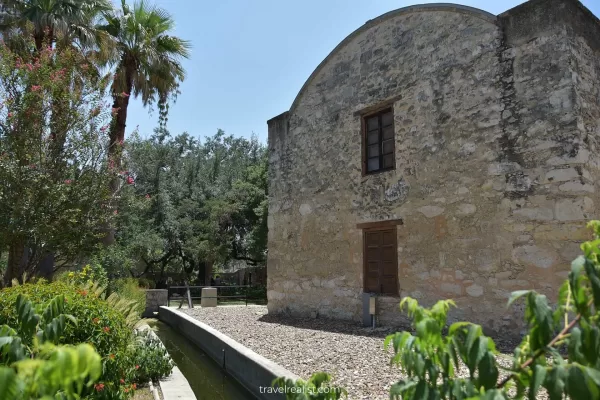National Mall: A Self Guided Walking Tour of Washington, D.C.
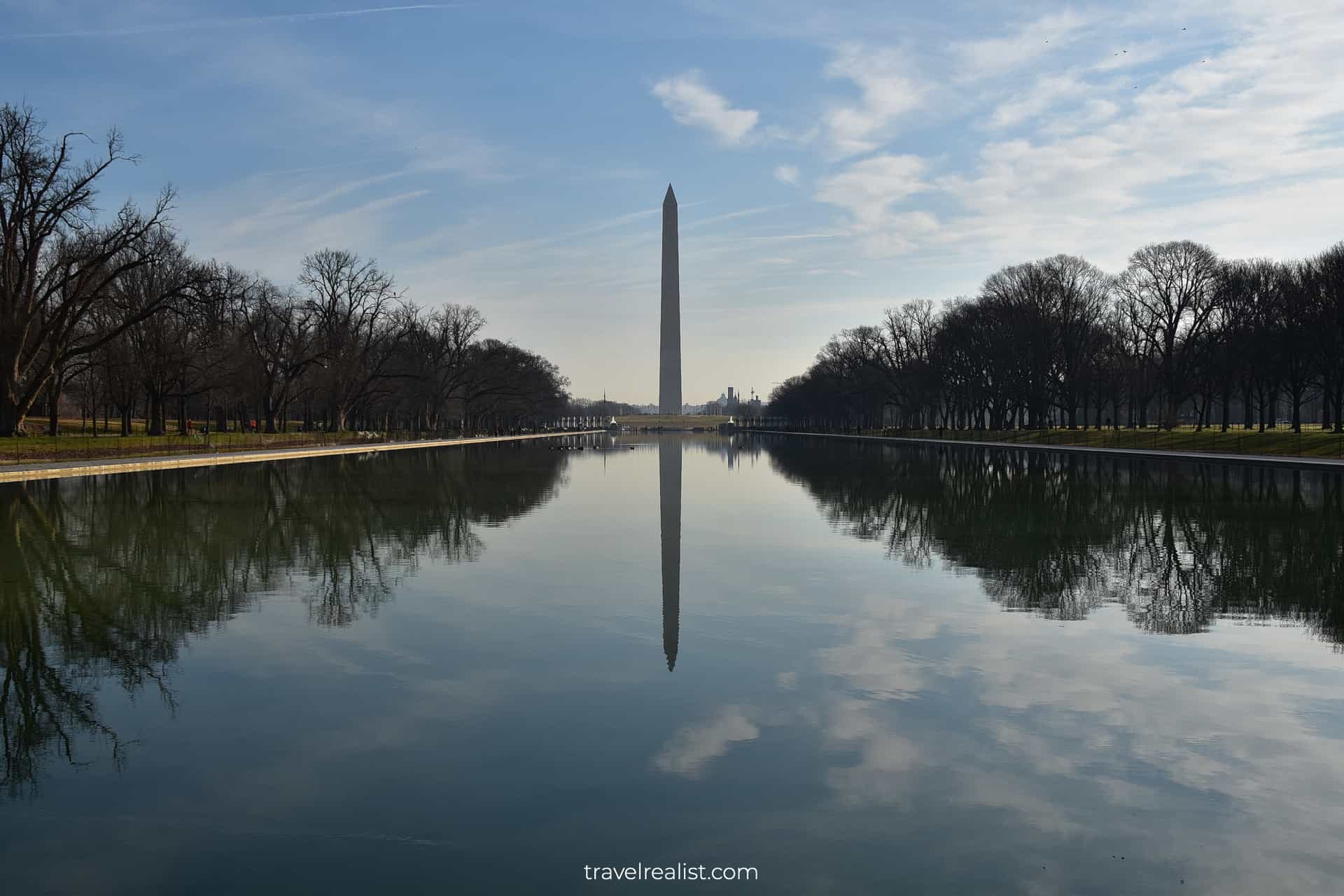
This realistic National Mall Self Guided Walking Tour Guide helps you plan your next visit to Washington, D.C.
The National Mall is a group of monuments, memorials, museums, and parks in the heart of the U.S. capital. There are so may sights at the National Mall that it is impossible to explore them all in one day.
- Sights & Places of Interest
- 1. Tidal Basin
- 2. Thomas Jefferson Memorial
- 3. Franklin Delano Roosevelt Memorial
- 4. Martin Luther King, Jr. Memorial
- 5. Lincoln Memorial
- 6. Reflecting Pool
- 7. World War II Memorial
- 8. Washington Monument
- 9. White House
- 10. Museums at National Mall
- 11. Smithsonian Castle
- 12. National Archives
- 13. National Gallery of Art
- 14. United States Capitol
- 15. Supreme Court
- 16. Library of Congress
- Getting to National Mall
- Where to Stay near National Mall
- Entrance Requirements & Passes
- Takeaways: National Mall Self Guided Walking Tour
This post includes affiliate links that will earn us commission if you make a purchase via these links.
The oldest buildings at the National Mall date back to the 1800s. Both the United States Capitol and the White House buildings opened in 1800.
The Lockkeeper’s House is the oldest building of the original Mall. This 1837 building has to do with the Chesapeake & Ohio Canal. It looks just as the Canal House in Waterloo Village in New Jersey.
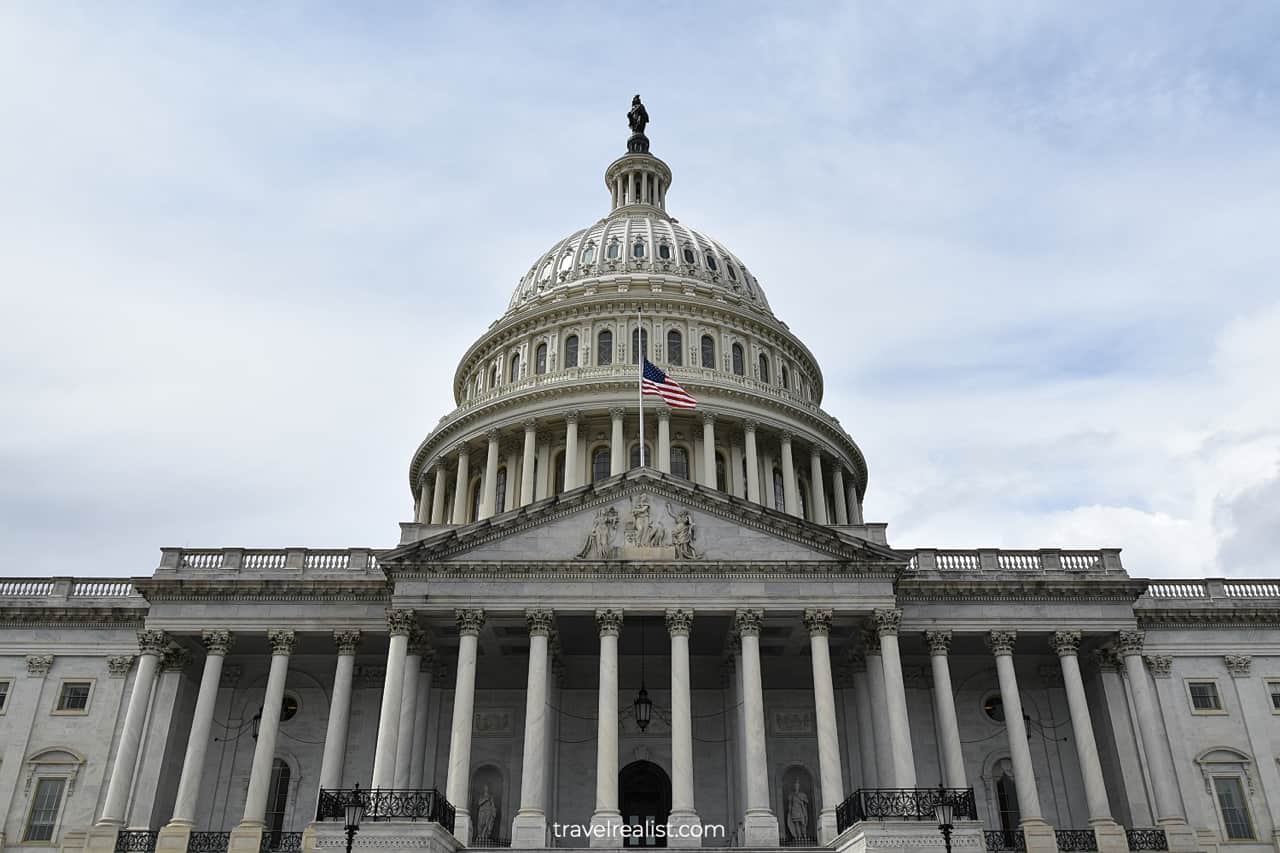
The National Mall has museums, memorials, and the main government buildings of the country. This way, it is a bit similar to Parliament Hill in Ottawa, Canada.
But the National Mall goes a lot further than its neighbor from “The Great White North”. You could enter and explore most National Mall buildings on a free self guided walking tour year round.
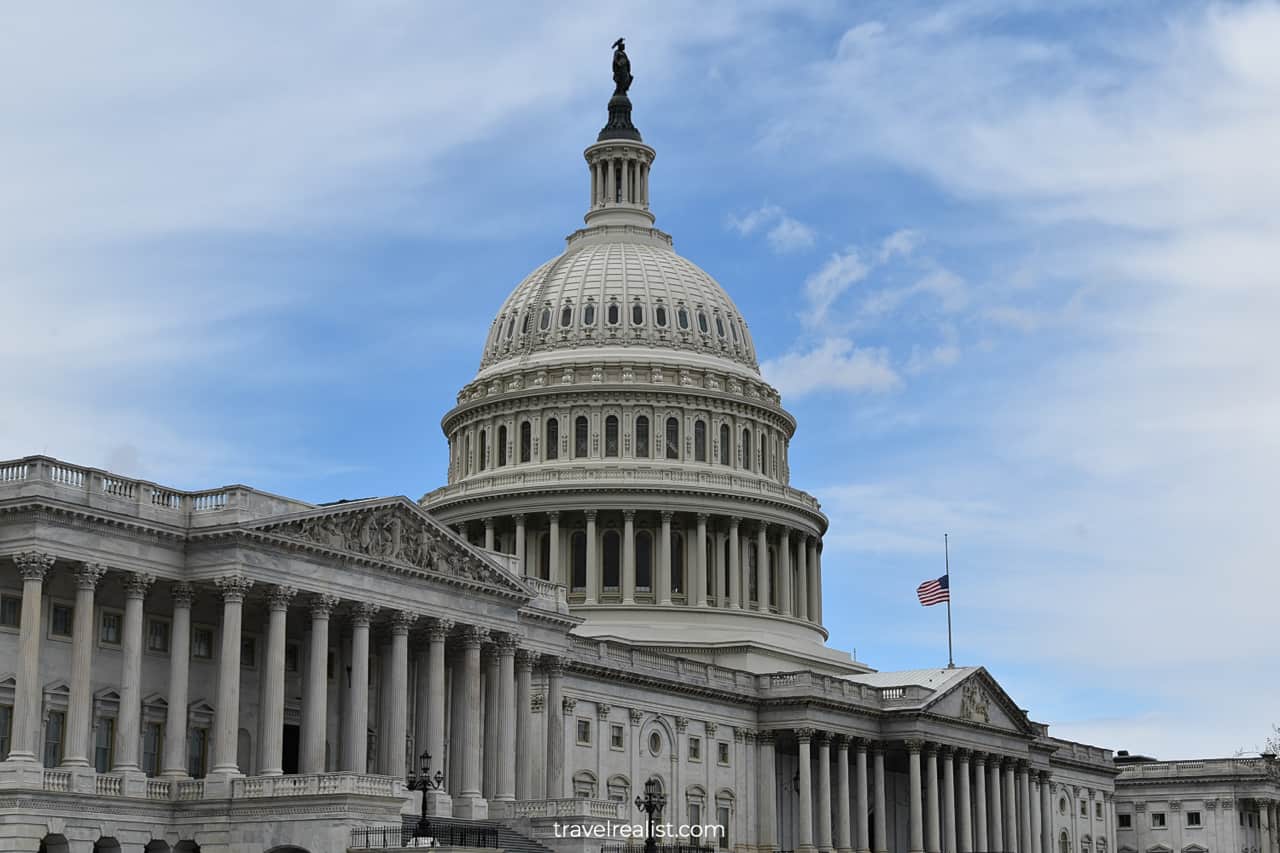
Sights & Places of Interest
The National Mall offers a lot of sights to its visitors. You could stop by the Thomas Jefferson and Lincoln Memorials. Climb atop of the Washington Monument for a birds’-eye view of the city.
See the White House and the United States Capitol. Tour the world famous Smithsonian Museums. Or just explore the Mall from the outside. The choice is yours. But you need to pick the sights to visit.
A self guided walking tour of the National Mall will differ a lot based on your preferences. If museums are your thing, you should visit them as early as possible. This way, you could see them with smaller lines.
This National Mall Self Guided Walking Tour Guide follows a different path. It brings you to the most scenic views at the Mall first. You will visit memorials before museums and the U.S. Capitol.
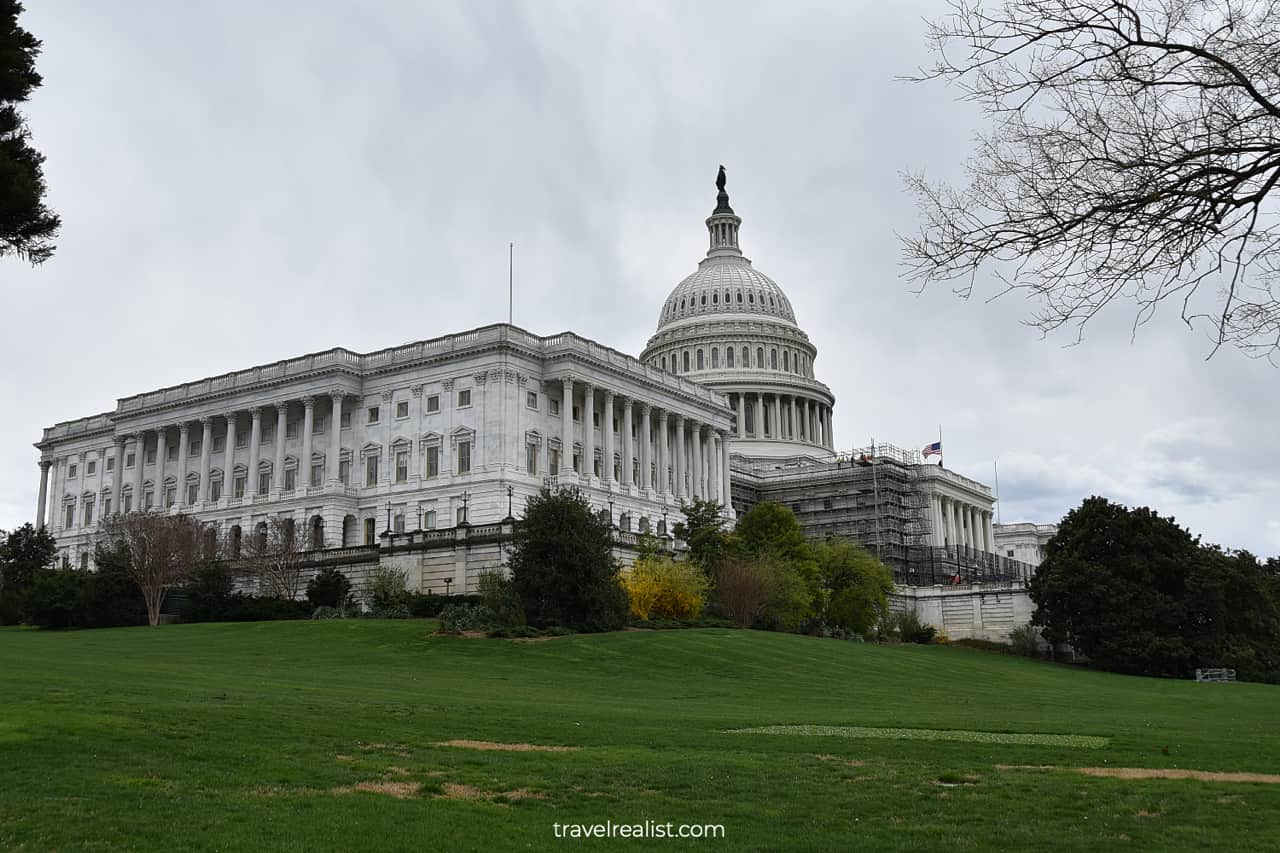
1. Tidal Basin
The Tidal Basin is a great start to your self guided walking tour of the National Mall. This large human made reservoir houses three memorials on its shores.
A walk around the Tidal Basin will bring you to Thomas Jefferson, FDR, and MLK Memorials. The Basin is the southernmost part of the National Mall. But you could reach other famous sights on a short walk.
An early morning with a breeze is the best time to enjoy the National Mall views. Calm waters of the Basin could help you capture reflections of the National Mall buildings in the water.
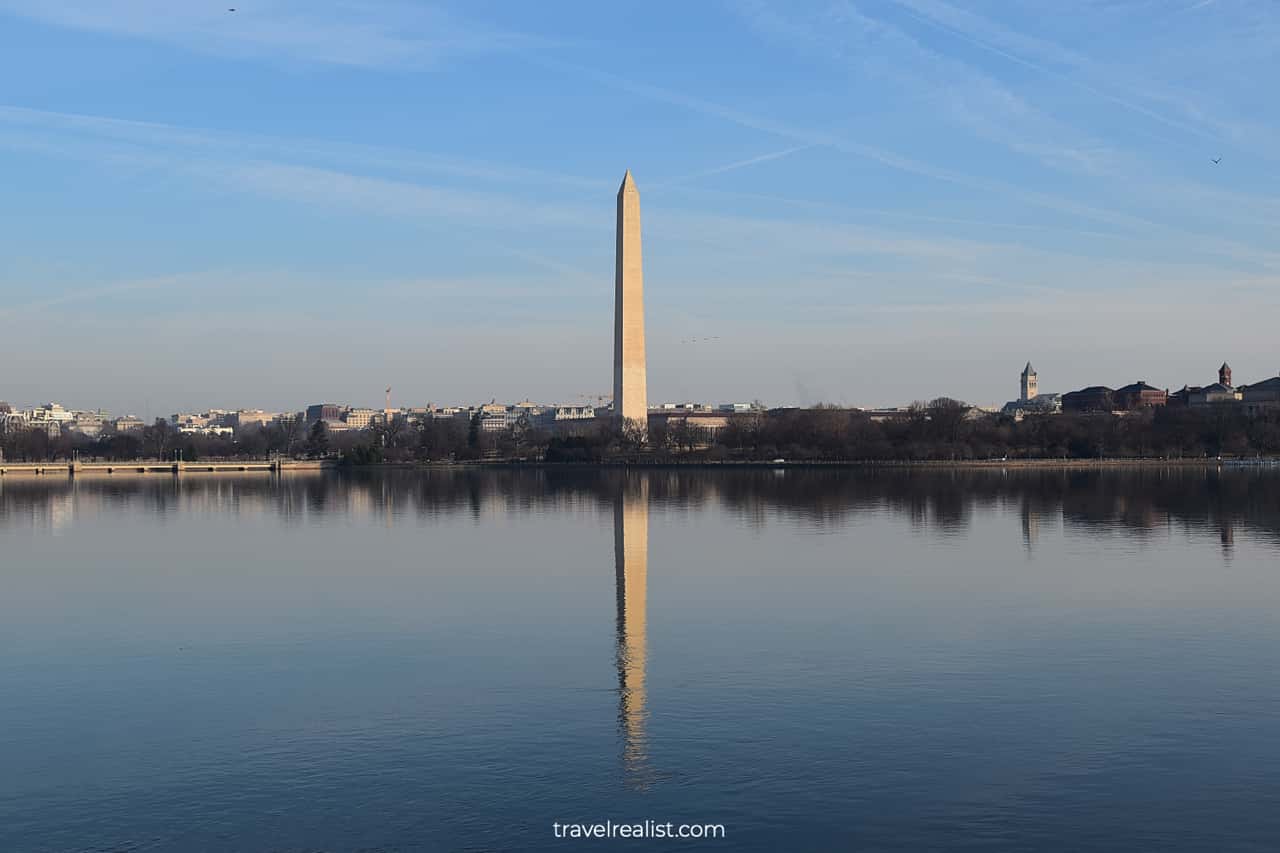
There is another reason to start your exploration of the National Mall early. Early morning hours after dawn are ideal for wildlife viewing. You might not expect to see wild animals in the middle of the city.
But the National Mall in Washington, D.C. could prove you wrong. If you are lucky, you could even see a bald eagle at the shores of the Tidal Basin.
Imagine spotting the National Bird of the United States in the capital of the nation. This could be a surreal encounter. Yet, bald eagles are more common at the National Mall than you think.

2. Thomas Jefferson Memorial
A clockwise walk around the Tidal Basin will bring you to the Thomas Jefferson Memorial. This circular Neoclassical building with a portico dates back to 1943.
The Memorial looks a bit like the Rotunda at the University of Virginia. A similar look and feel is on purpose. Jefferson designed the Rotunda. This was a way for the architect to give tribute.
Cherry blossom trees are next to the Thomas Jefferson Memorial. This view attracts countless visitors during the Cherry Blossom season in March.
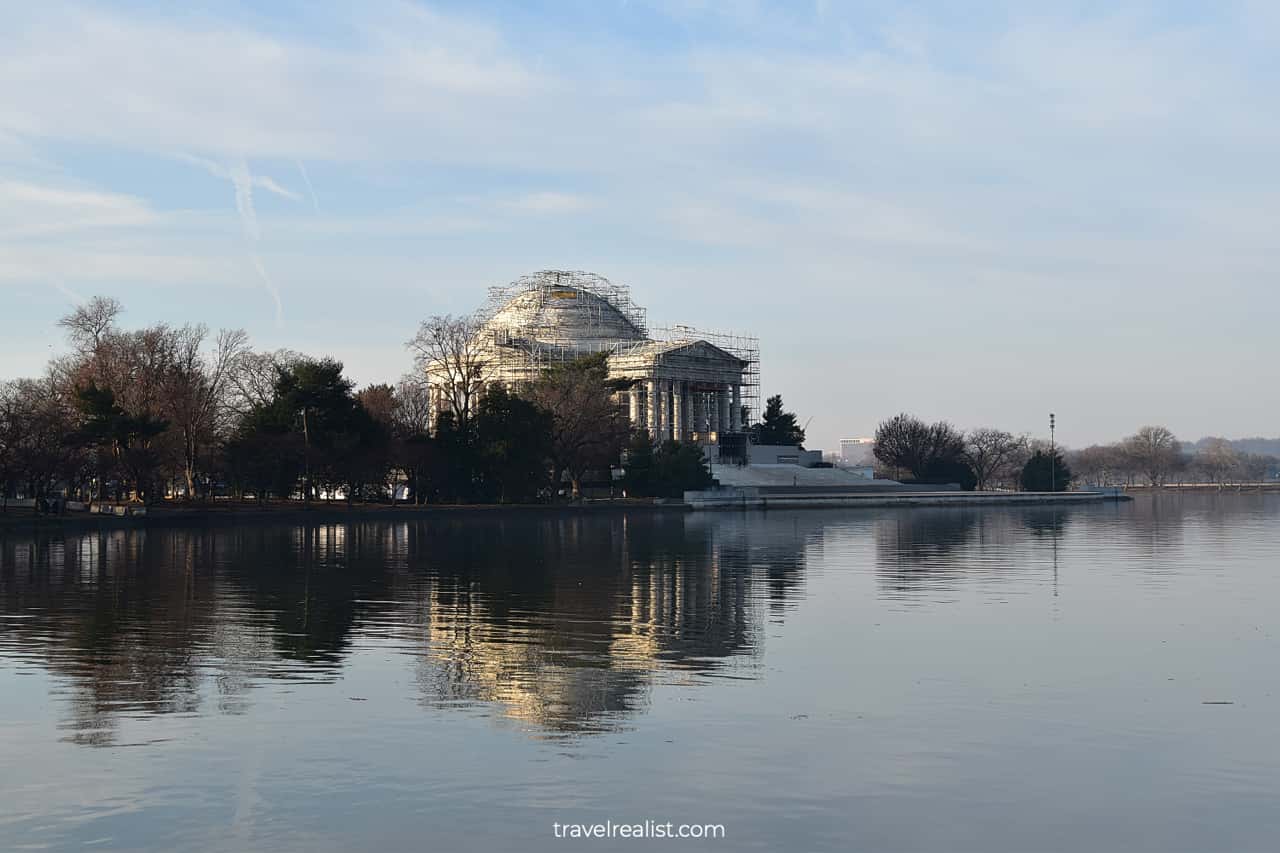
You could head inside the Memorial. Get ready to see a 19 ft (5.8 m) tall bronze statue of Thomas Jefferson. The statue with a pedestal will make you feel small in comparison.
Take a look at the inscriptions on the walls. They all are quotes from Thomas Jefferson. You could learn more about the views of the 3rd President of the United States
The Thomas Jefferson Memorial is an open air structure. This is true of all memorials at the National Mall. Do not expect to warm up inside the Memorial like in the Parthenon in Nashville, Tennessee.
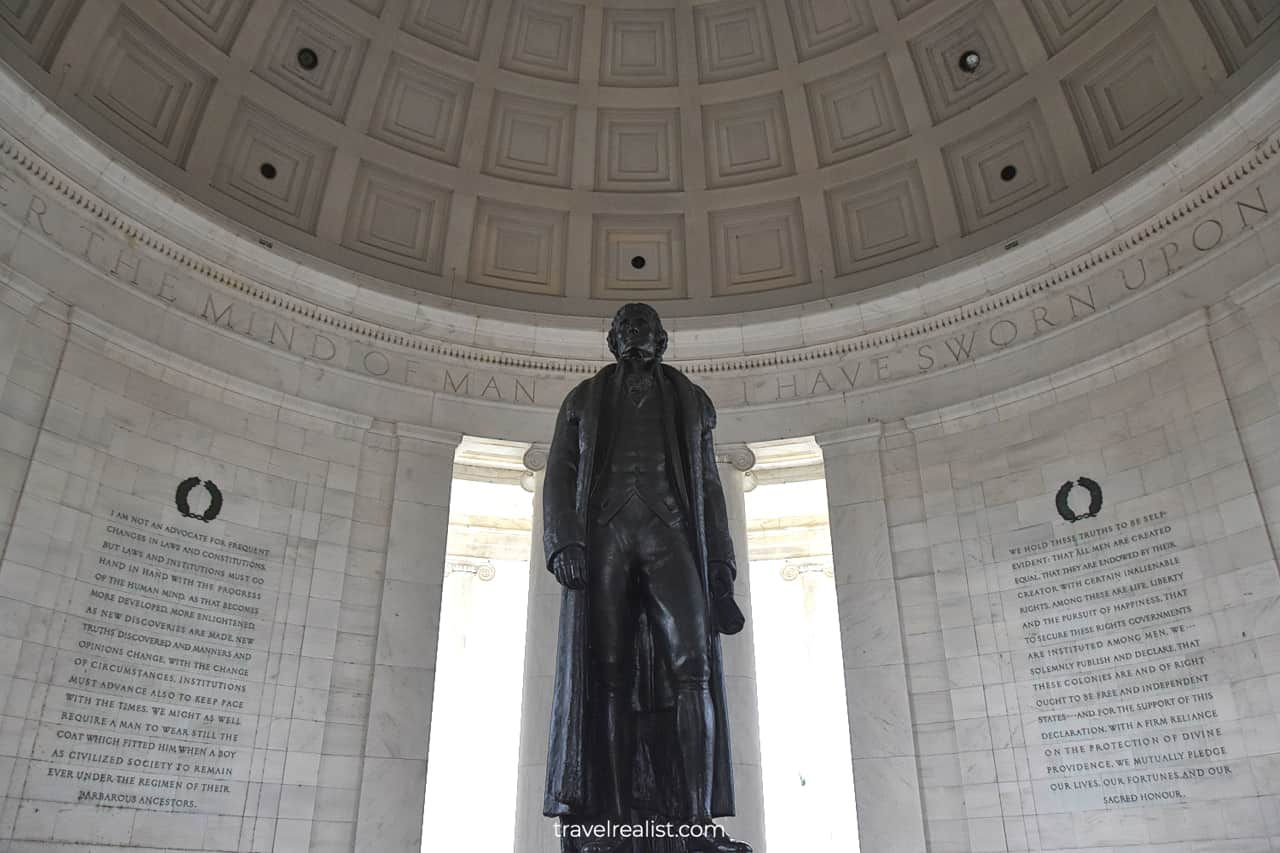
3. Franklin Delano Roosevelt Memorial
Your self guided tour of the National Mall continues on the shores of the Tidal Basin. You will pass George Mason Memorial and cross the Inlet Bridge on the way to the next stop.
You will arrive at the Franklin Delano Roosevelt Memorial. This 1997 Memorial is nothing like the Jefferson Memorial. You could best describe it as a stone maze with waterfalls, pools, and carvings.
Its four rooms tell a story about four terms of the 32nd President from Hyde Park, New York. You need to go inland to learn more. But there might be a good reason to stick to the shore.
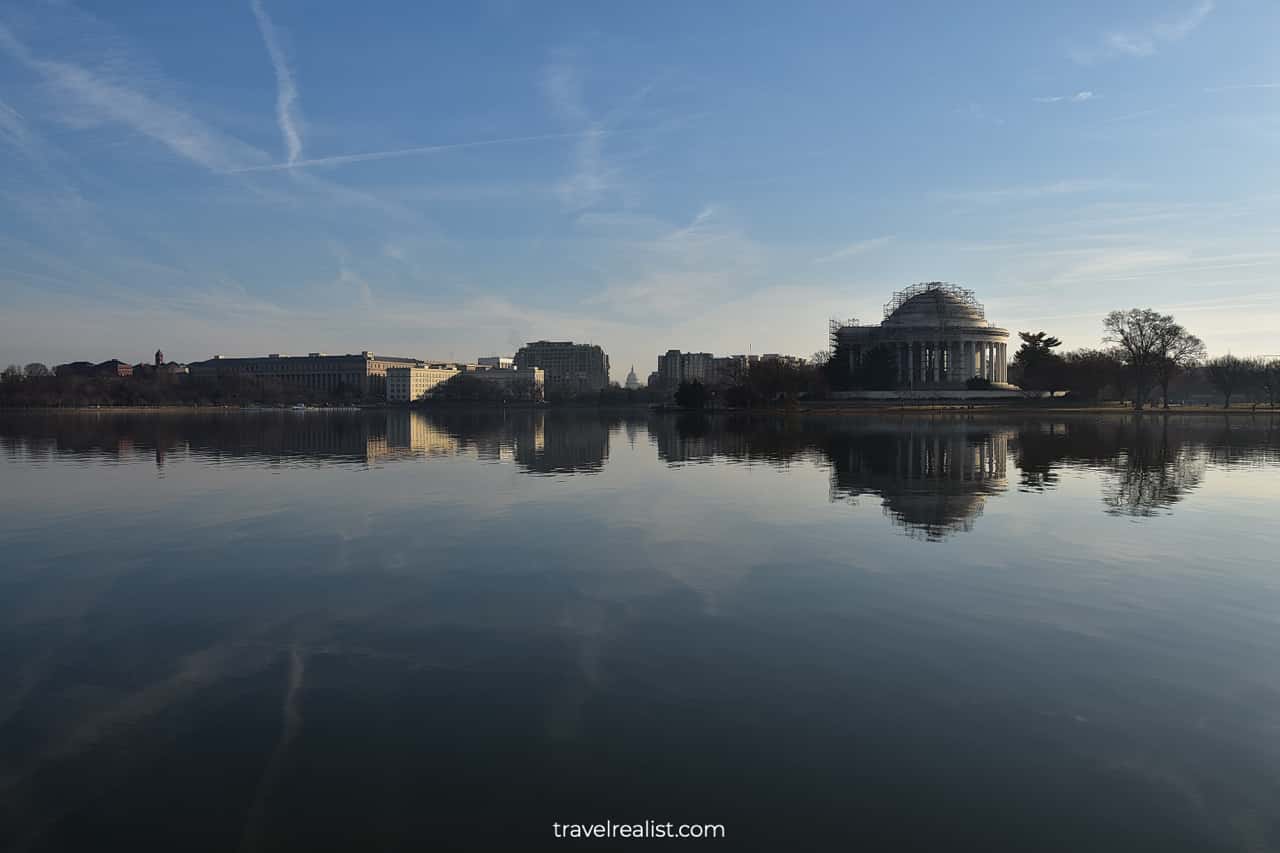
Stop by the Japanese Pagoda. You will find lots of Japanese cherry trees on this shore of the Basin. They transform the Tidal Basin into a field of white and pink blossoms in March.
There is still a lot to explore even if you visit the FDR Memorial during the rest of the year. The Japanese Pagoda is a great place to see a panorama of the Tidal Basin.
The Thomas Jefferson Memorial reflection will be in the forefront. You could even see the United States Capitol thanks to a clear line of Maryland Avenue.
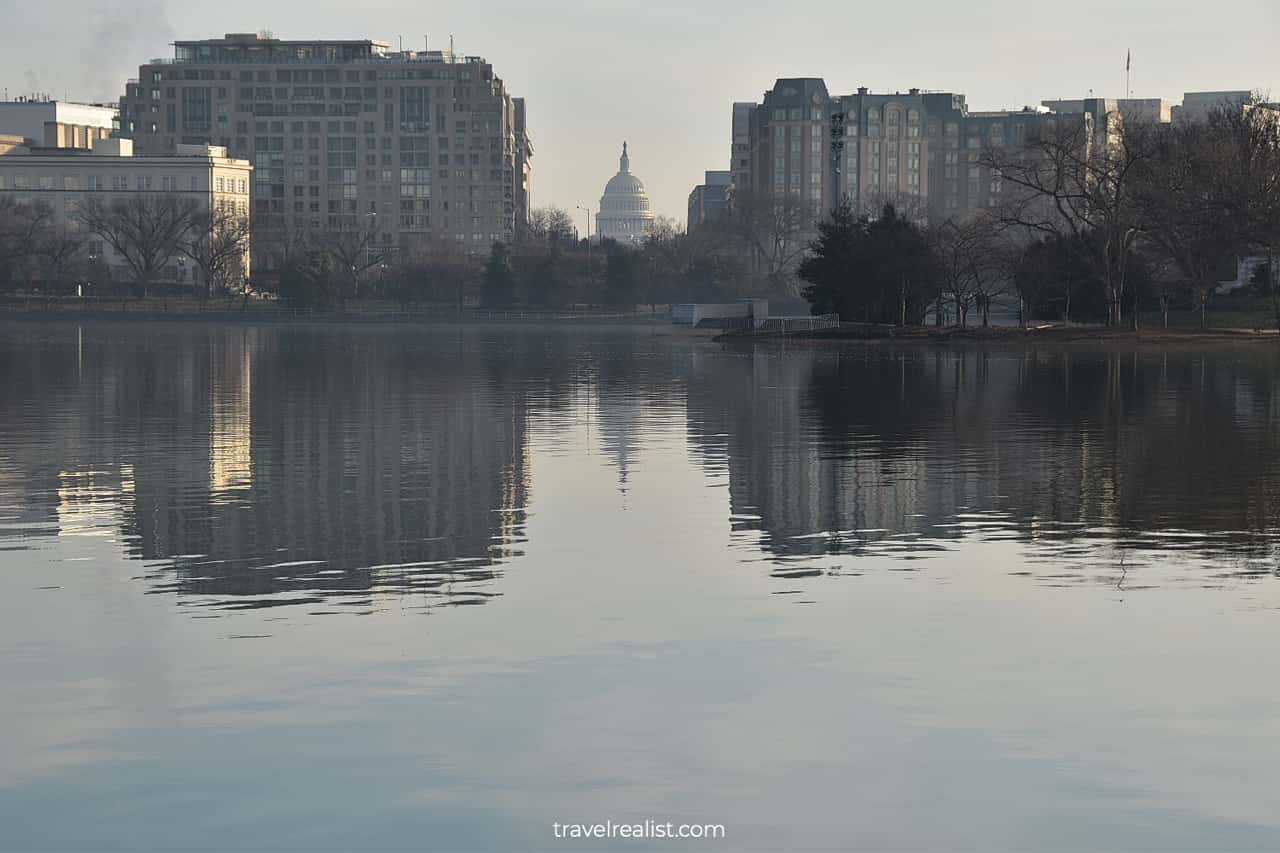
4. Martin Luther King, Jr. Memorial
Continue your walk along the cherry trees. The Martin Luther King, Jr. Memorial will be the next stop on your walking tour of the National Mall.
This Memorial is a more recent addition to the park. It dates back to 2011. A carved statue of MLK has some resemblance with Mount Rushmore carvings in South Dakota.
The MLK Memorial gives you an option to explore other sights by crossing Independence Avenue. Your self guided walking tour of the National Mall brings you through Ash Woods to the Lincoln Memorial.

5. Lincoln Memorial
The Lincoln Memorial is one of the most famous buildings in Washington, D.C. This 1922 building was the first memorial at the National Mall. The Memorial is a Greek Revival temple.
The Memorial has become an iconic place in the United States history and culture. The Civil Rights and Anti-War protests took place on the steps of this building.
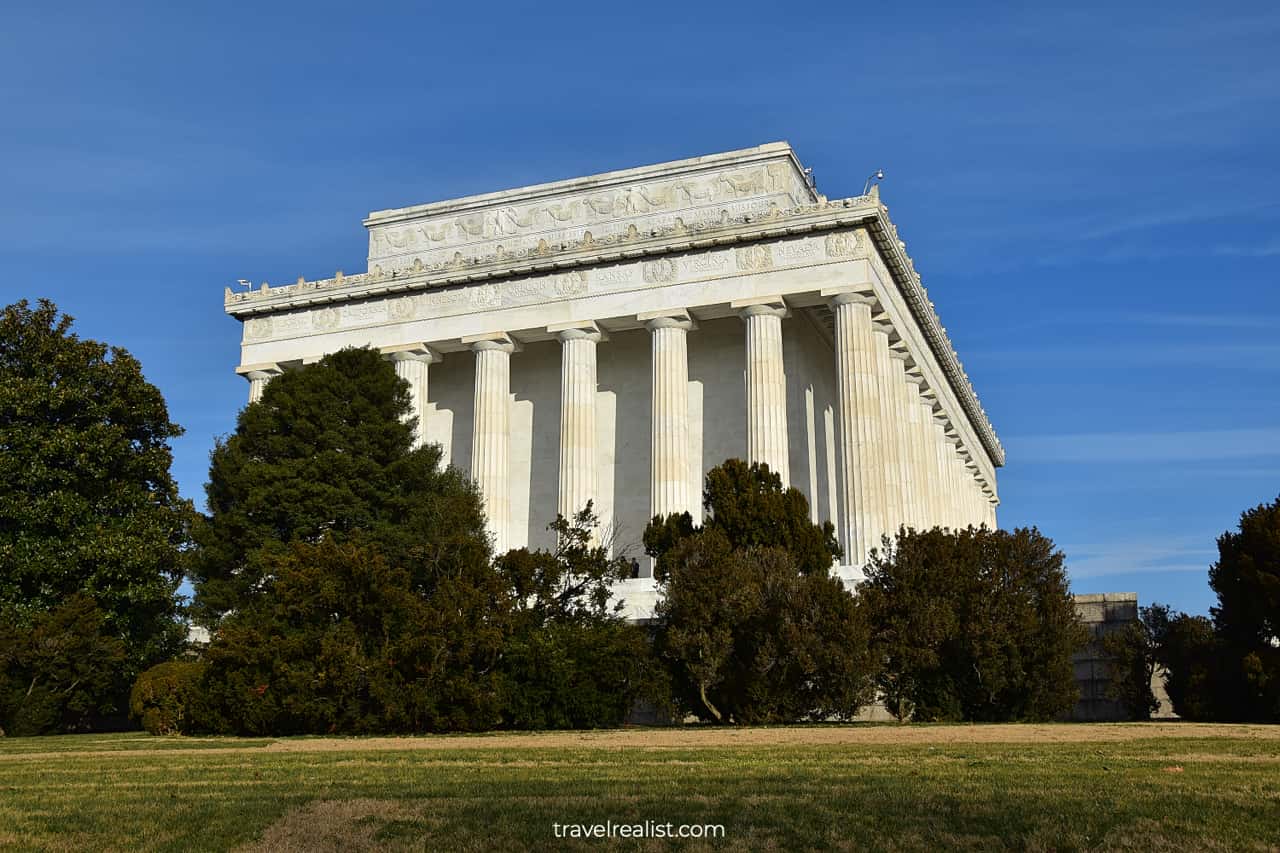
The interior of the Lincoln Memorial is somewhat similar to the Thomas Jefferson Memorial. You will find a 19 ft (5.8 m) tall and 19 ft (5.8 m) wide sculpture of Abraham Lincoln inside.
There is a famous inscription behind the marble statue. Two other inscriptions and a few murals are on the walls of the Memorial. This building is a very powerful place if you like history.
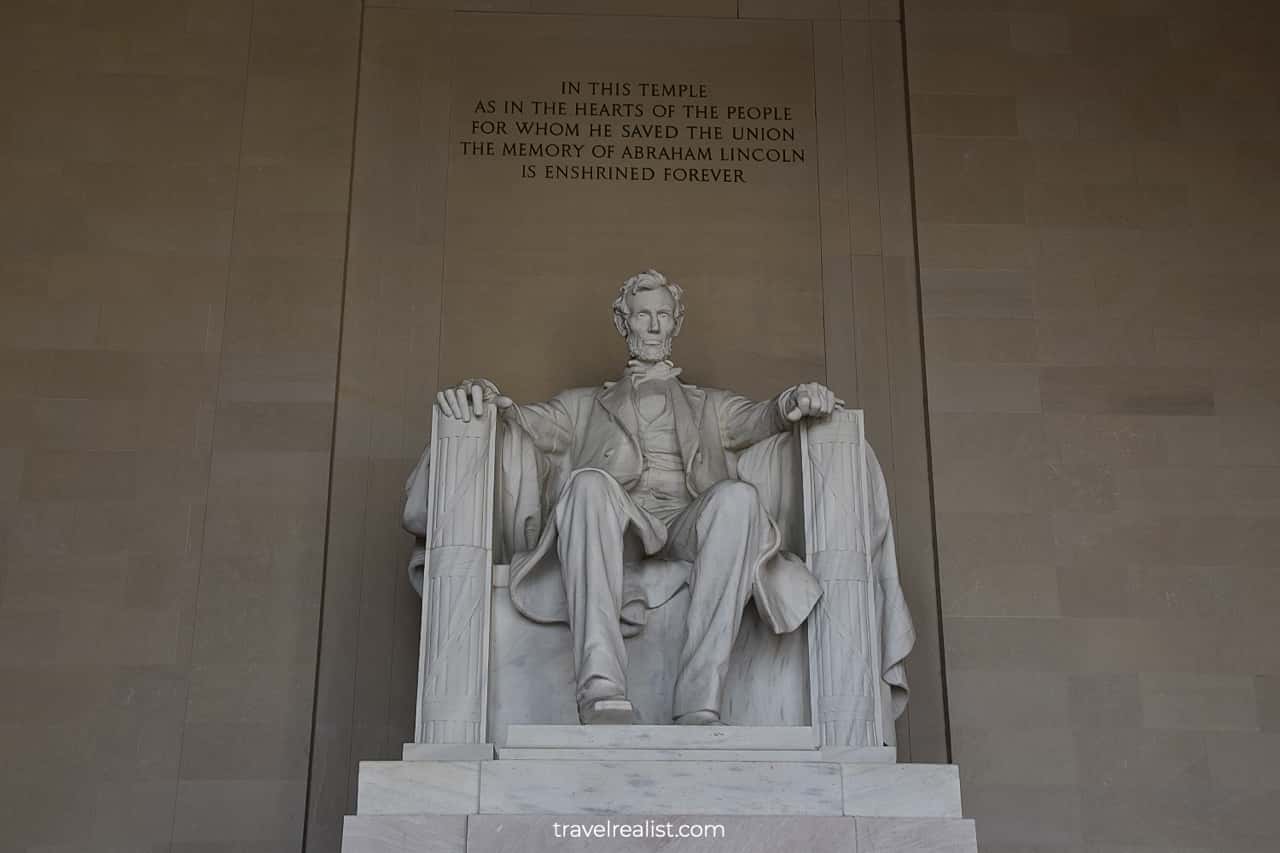
6. Reflecting Pool
You cannot miss the Reflecting Pool. The pool is part of the Lincoln Memorial. Yet, it has become an attraction by itself. The National Mall visitors come there to capture beautiful reflections.
Shallow waters of the pool make it a simple task no matter when you visit. Head to the steps of the Lincoln Memorial. You could enjoy an iconic reflection of the Washington Monument.
Here is another advantage of coming to the National Mall early. You might get a picture of the Washington Monument without a person in sight.
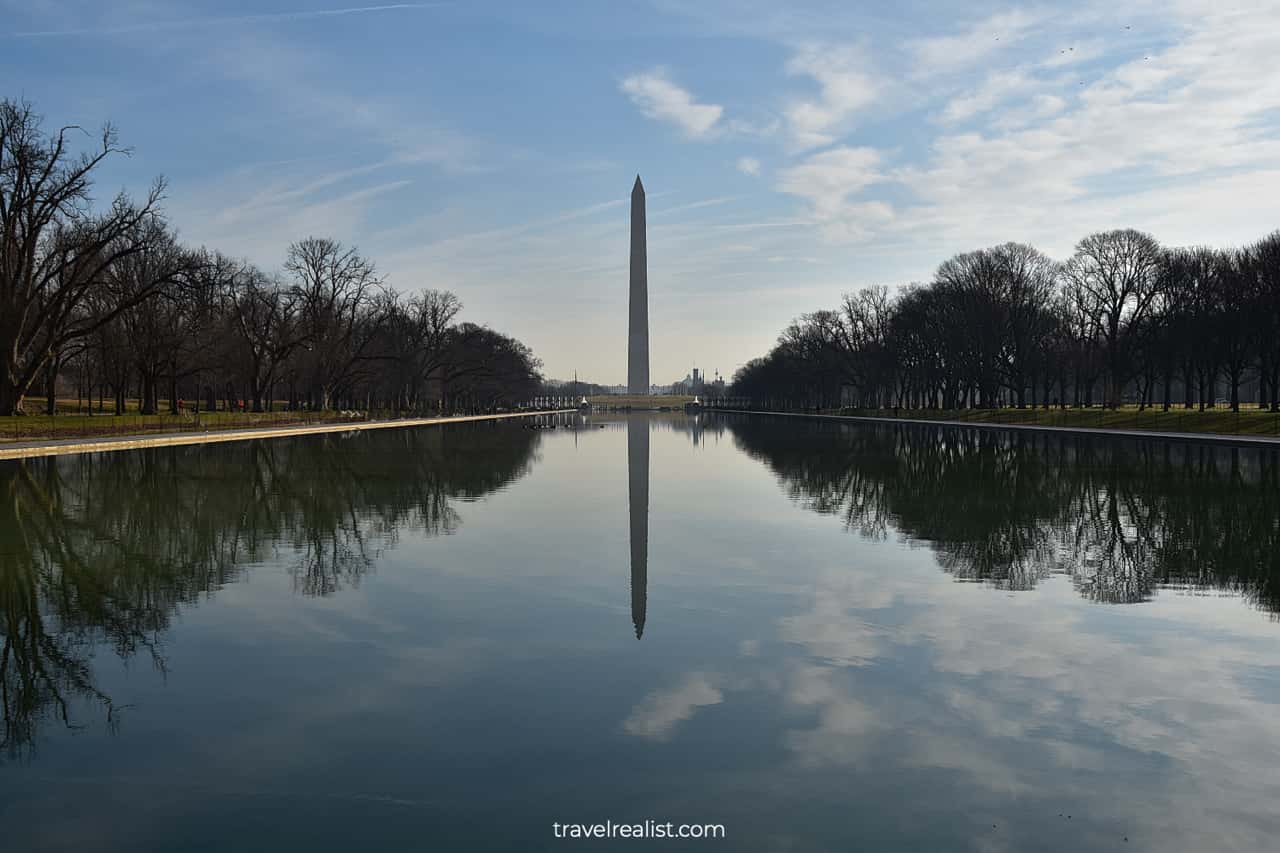
Your self guided walking tour of the National Mall could continue on either side of the Reflecting Pool. There are no notable structures all the way to the World War II Memorial.
Instead, you could take a path just slightly north of the Pool. This way, you could visit Vietnam Veterans Memorial and related sights. See the 56 Signers of the Declaration of Independence next.
You should return to the Reflecting Pool just before crossing 17th Street. You are welcome to enjoy a reflection of the Lincoln Memorial in the distance.
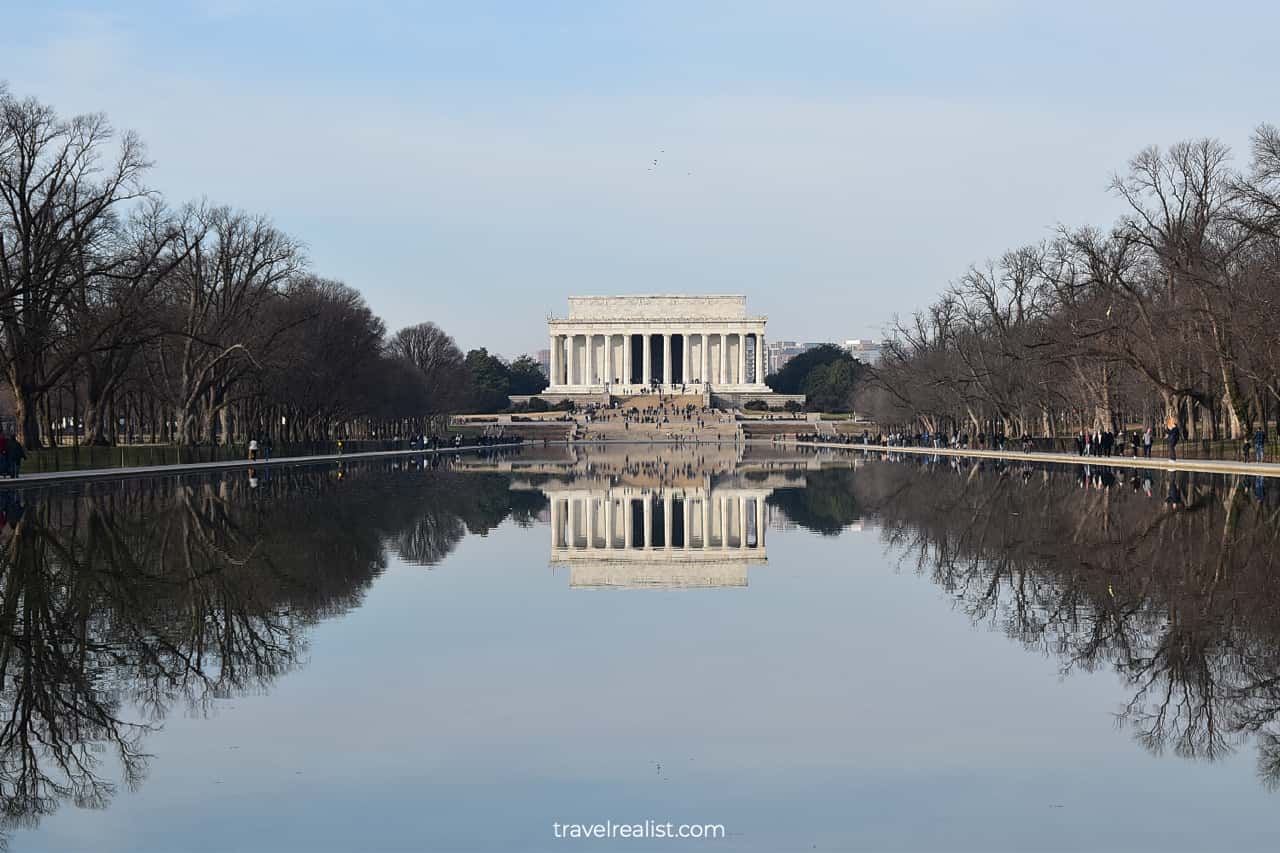
7. World War II Memorial
As you probably guessed, the WWII Memorial is the next stop on your walking tour through the National Mall. It became part of the National Mall just 20 years ago.
There are 56 pillars. Each of them represents a U.S. state or a territory. The pillars surround an oval fountain. You should take a moment think about the price of freedom there.
The location of the World War II Memorial gives you more ways to enjoy scenic views. Catch a glimpse of the United States Capitol and the Library of Congress buildings.
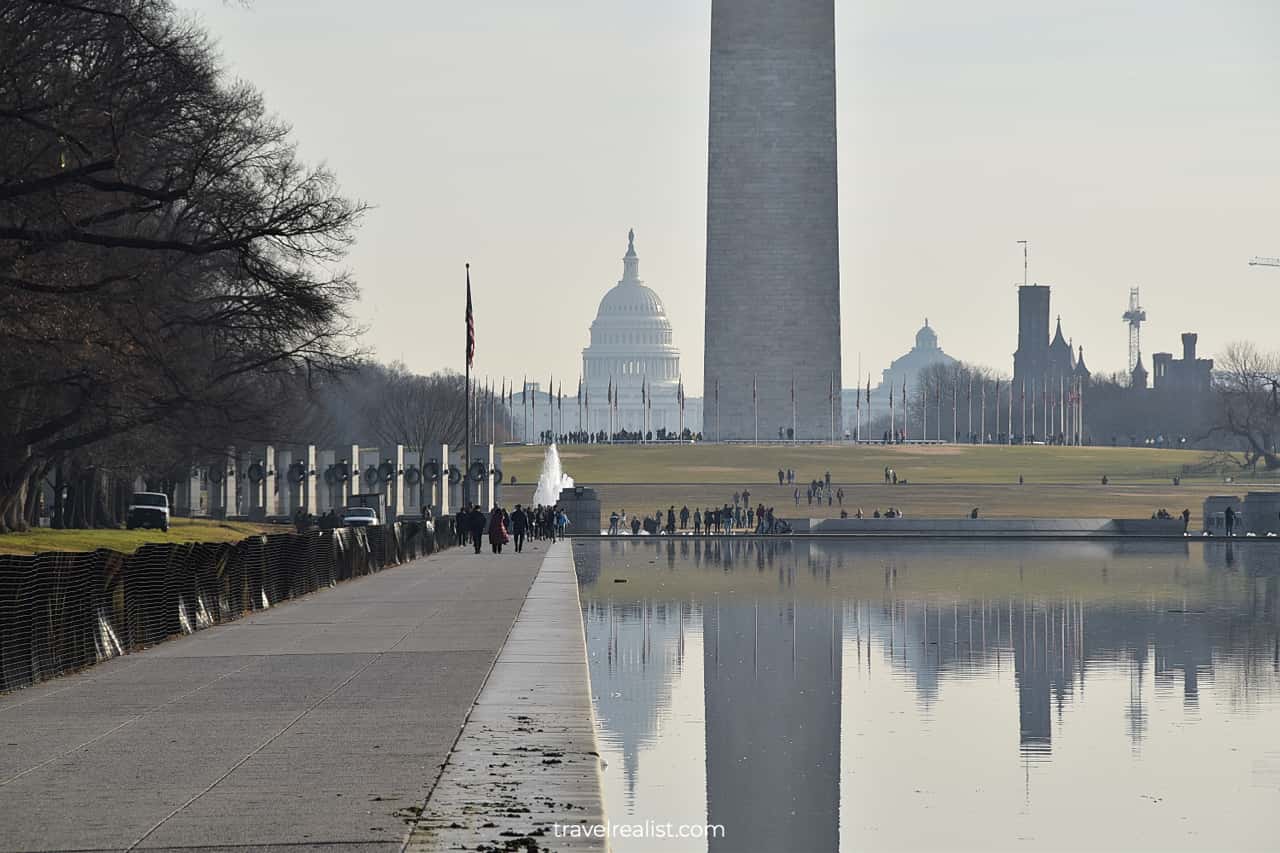
8. Washington Monument
Once you cross 17th Street you will be on the Washington Monument grounds. The west side of the grounds is a large green lawn with a few paths. They all lead to the Monument.
Without a doubt, the Washington Monument is one of the highlights of the National Mall. This 555-ft (169-m) obelisk dates back to 1884.
Two types of stone were used to build the Monument. You could easily tell the difference between the earlier (light) and later (dark) parts thanks to the differences in color.
As you might know, a few obelisks in the United States have an observation deck on top. The Washington Monument is no different. You could take an elevator to the top from 9 a.m. to 5 p.m. on most days.
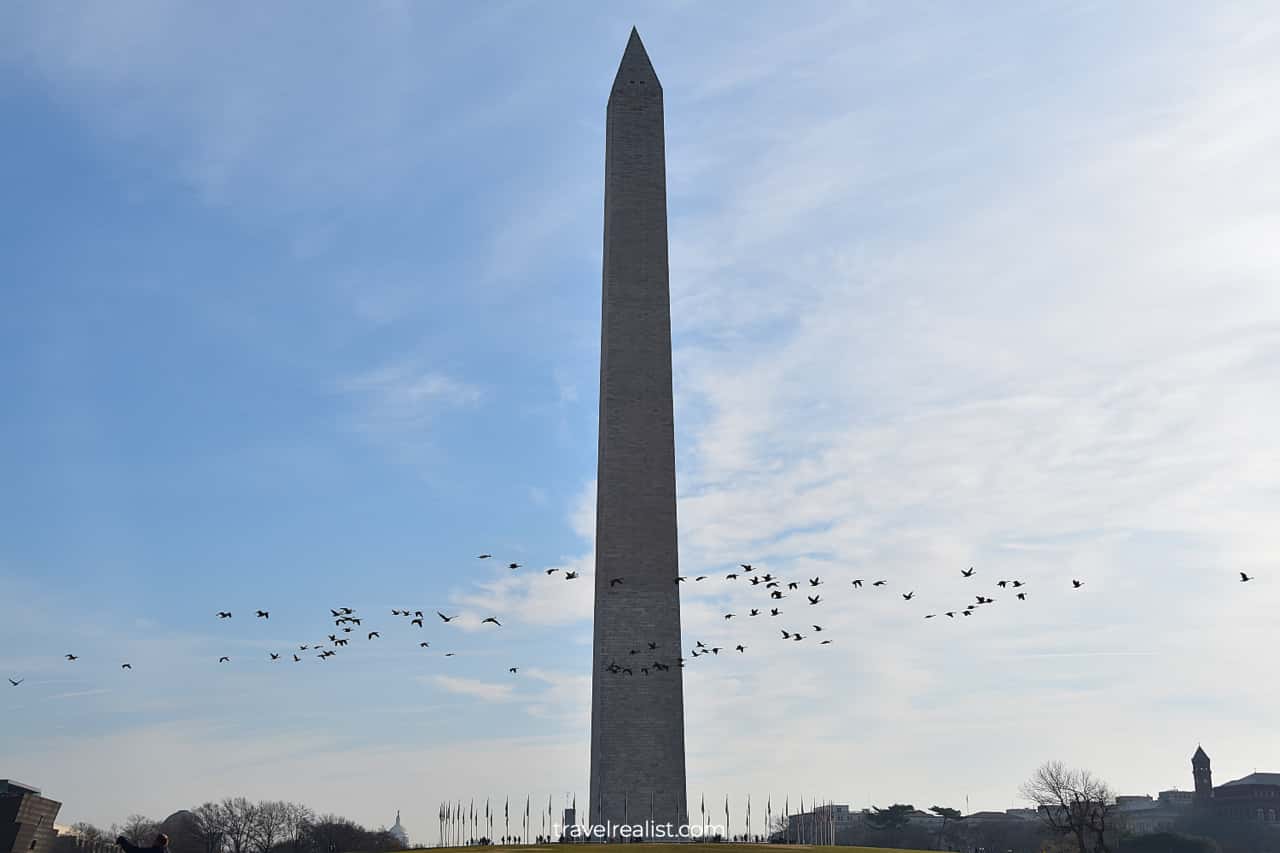
But you need a timed reservation to visit the Monument. You could get it up to 30 days in advance for a $1 reservation fee. Or you could try your luck and get it for free on the day of your visit.
You should continue to be on the lookout for wildlife as you navigate through the National Mall. This is also true at the Washington Monument. You might see a skein of geese flying across the National Mall.
Geese seem to enjoy the most famous sights on the Atlantic Coast. The Washington Monument is far from being alone. There are countless geese at the Statue of Liberty in New York Harbor, too.

9. White House
The grounds of the Washington Monument show a glimpse of the White House. The residence of the President of the United States dates back to the year 1800.
The White House is about six blocks north of the Washington Monument. It will take you about 20 minutes to reach it on foot. A stop at the White House will add about an hour to your walking tour.
The White House is open to the public. But touring the residence requires some preparation. You should contact your Member of Congress (for US citizens) or Embassy (for foreign nationals) to arrange a tour.
Security precautious make it difficult to get an iconic view of the White House and the South Lawn. It is better to see the White House from an observation deck at the Washington Monument.
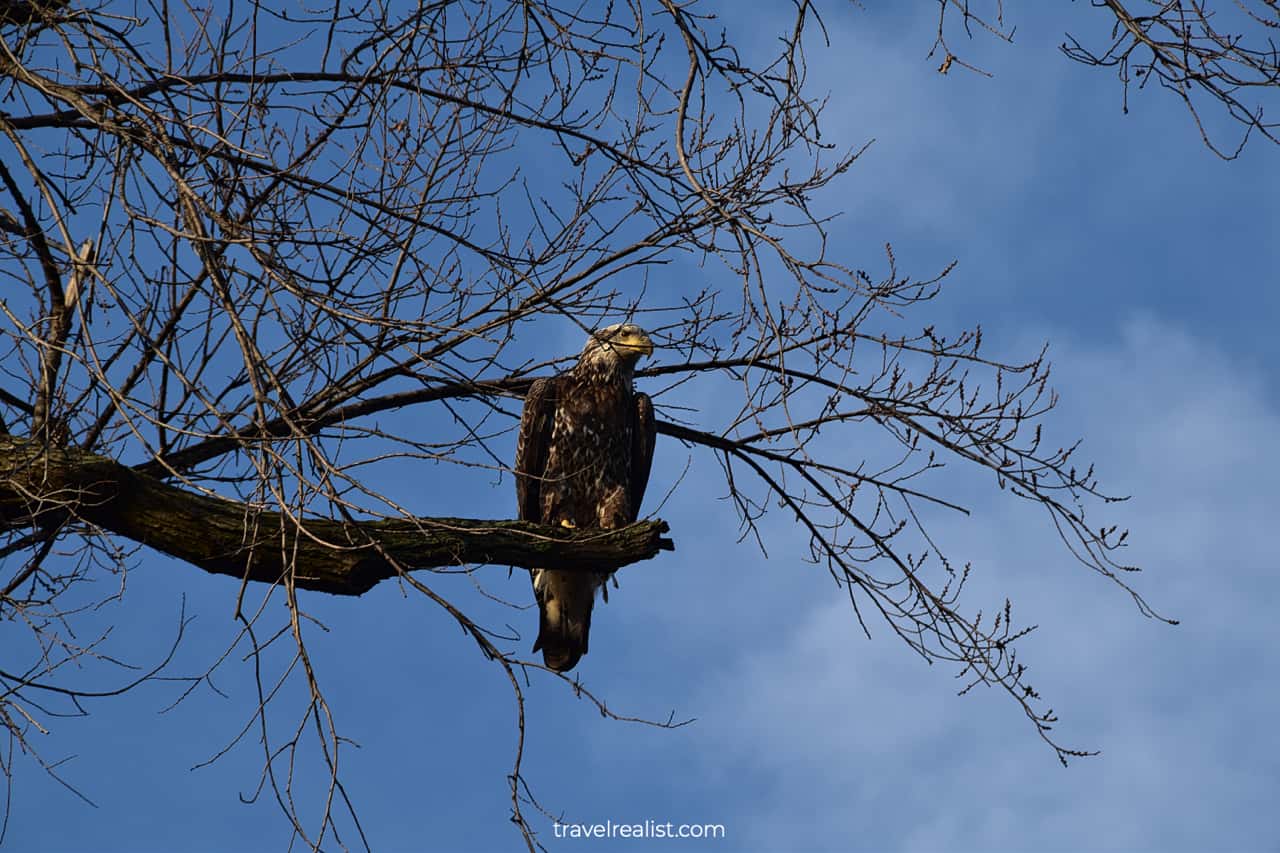
10. Museums at National Mall
You could refer to the section of the National Mall between the Washington Monument and the U.S. Capitol as the Mall. It is home to most museums in the park. Here are 10 main museums at the Mall.
- National Museum of African American History and Culture
- National Museum of American History
- National Museum of Natural History
- National Archives Museum
- National Gallery of Art and its East Building
- National Museum of the American Indian
- National Air and Space Museum
- Hirschhorn Museum
- National Museum of African Art
- National Museum of Asian Art
There are a handful of other museums a couple of blocks from the National Mall. You could easily spend a day just touring the museums. But unless you have a full weekend, you would need to prioritize.
This National Mall Self Guided Walking Tour Guide only covers the National Archives Museum and the National Gallery of Art. But it starts with the Smithsonian Castle.
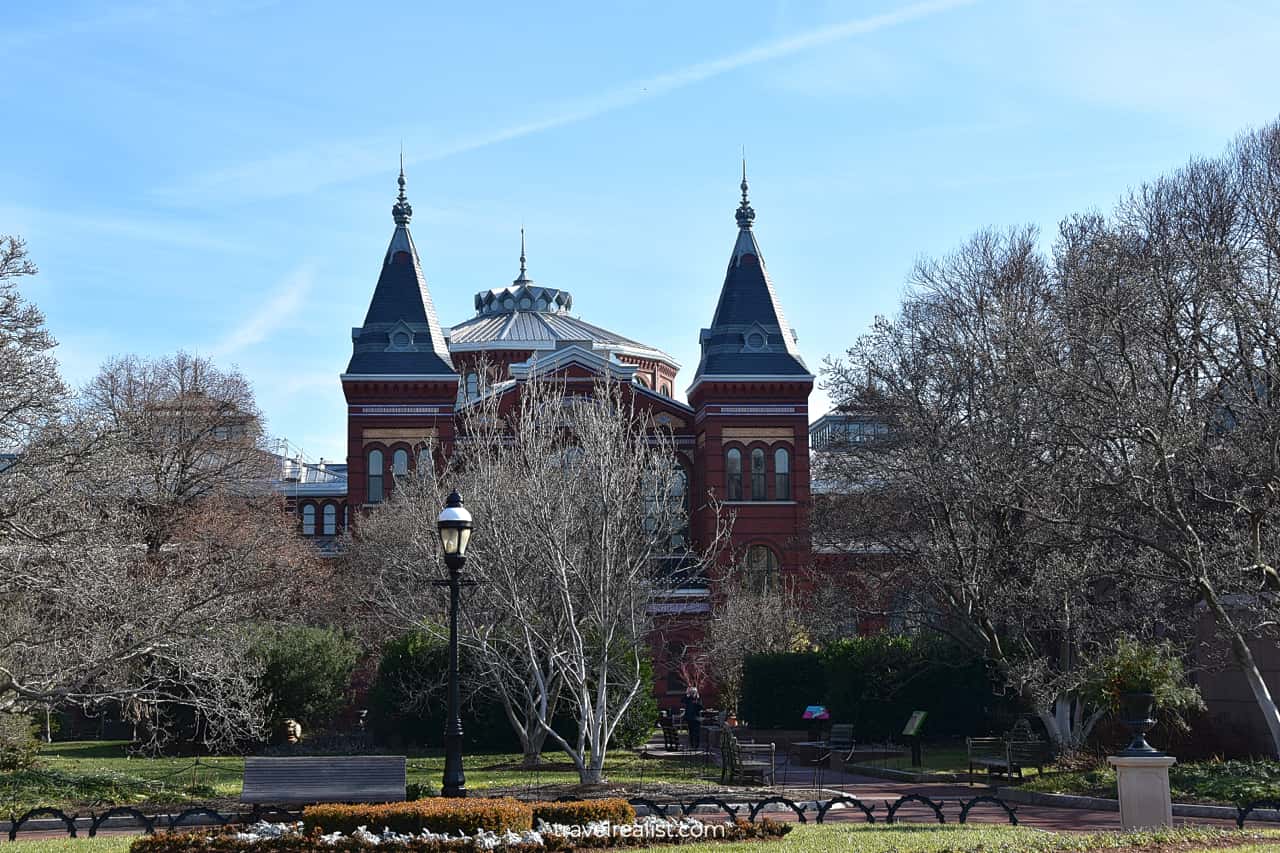
11. Smithsonian Castle
The Smithsonian Institution Building or simply the Smithsonian Castle is a beautiful 1855 building. You could be imagining a castle similar to Casa Loma in Toronto, Canada.
In this case, you would not be too far from reality. But the Smithsonian Castle looks most similar to the Gothic buildings of the University of Chicago. You could explore the Castle from the outside.
It houses the offices of the Smithsonian Institution. This organization manages most museums at the National Mall. The Castle was also a visitor center until it closed for renovation in 2023.
As you make your way through the National Mall, stop by the Arts and Industries Building. This 1879 building is the second oldest among the Smithsonian Museums.
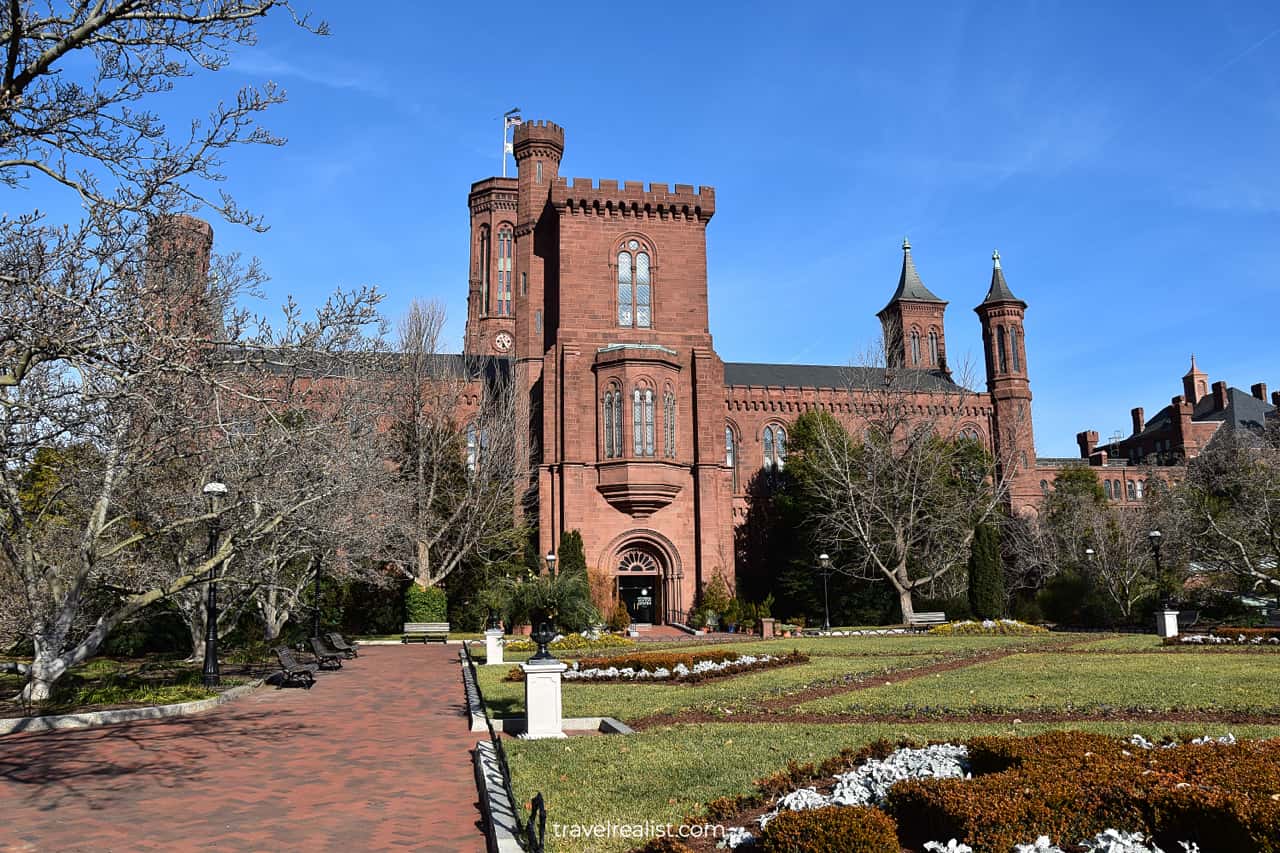
12. National Archives
If you cross the Mall from the Castle via the Sculpture Garden, you will arrive at the National Archives. This museum has the Declaration of Independence, Constitution, and Bill of Rights.
You could enter the National Archives Museum from 10 a.m. to 5:30 p.m. every day. Admission is free. Feel free to take pictures inside without flash. But mind the low light conditions inside the building.
You do not have to make a timed entry reservation to visit this museum. But you might want to get one if you visit between March and September. A $1 per ticket fee is worth a chance to skip the line.
Use the saved time to visit Ford’s Theatre nearby. Make sure to reserve tickets in advance for a $3.5 per ticket fee. And observe squirrels beg tourists for food.

13. National Gallery of Art
Once you come back to the Mall, you could choose to visit one or two other museums. If you like art, the choice is clear. You cannot go wrong with the National Gallery of Art.
The National Gallery dates back to 1937. It consists of two buildings. The West Building is a 1941 construction. The East Building dates back to 1978 and has a more contemporary design.
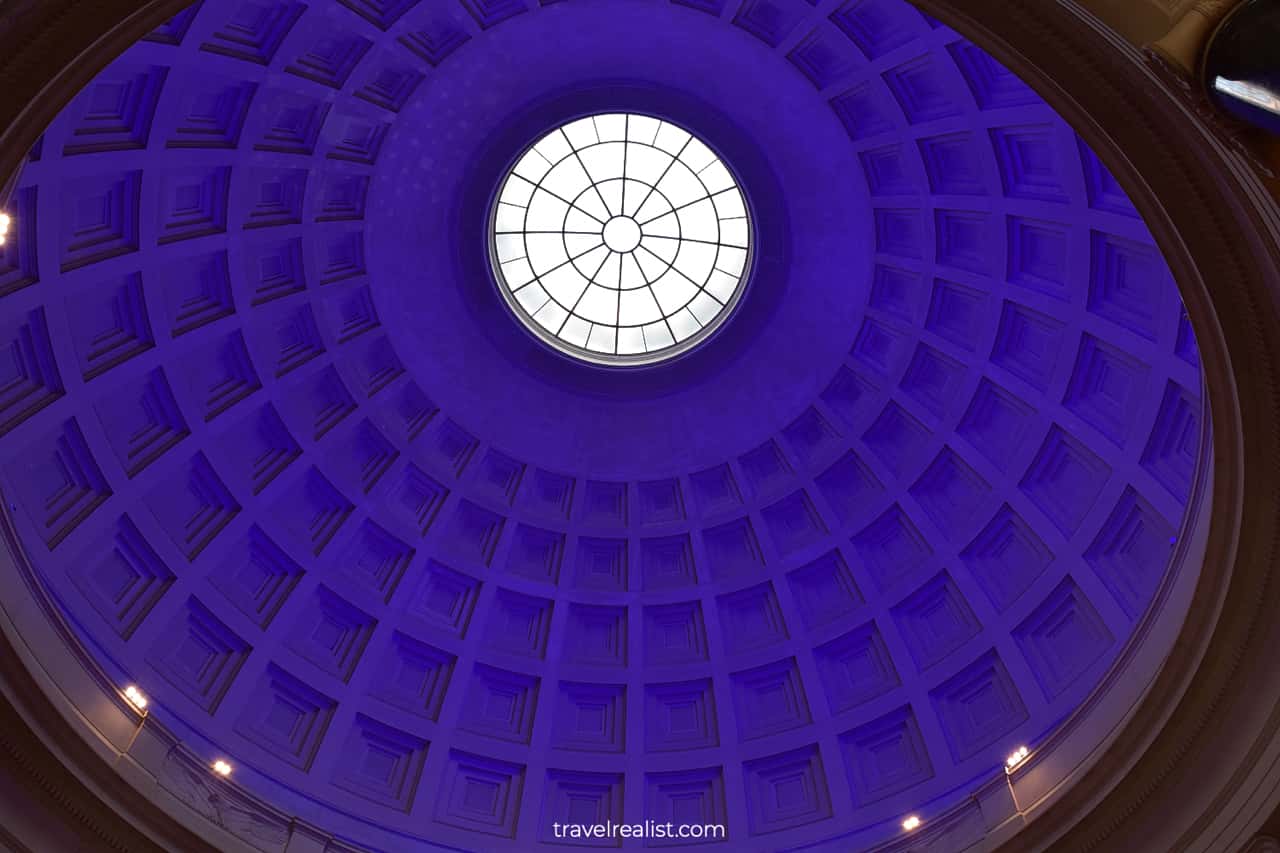
The buildings also differ in the types of art exhibits. Head to the West Building to see the classical paintings up until the 19th century. A few national treasures are on display in the National Gallery of Art.
The East Building is home to the modern art of the 20th and 21st century. There are plenty of masterpieces to see in that building, too. Prepare to spend at least an hour to tour each building.
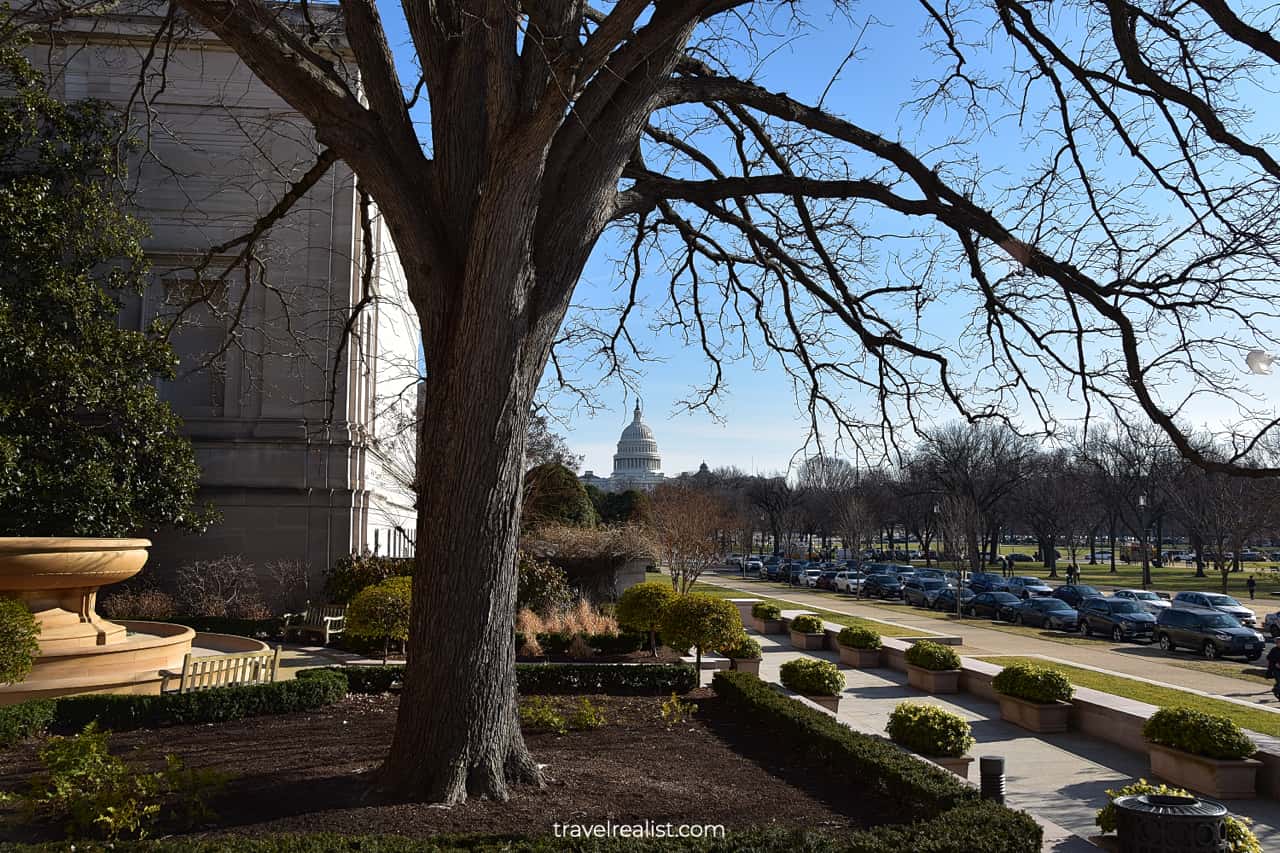
14. United States Capitol
Once you finish exploring the works at the National Gallery, you could continue with the walking tour. The United States Capitol building is a few blocks east. It is a crown jewel of the National Mall.
The U.S. Capitol building dates back to 1800. It is one of the oldest government buildings in the country. It is so large that you could only fit it in one picture near 7th Street.
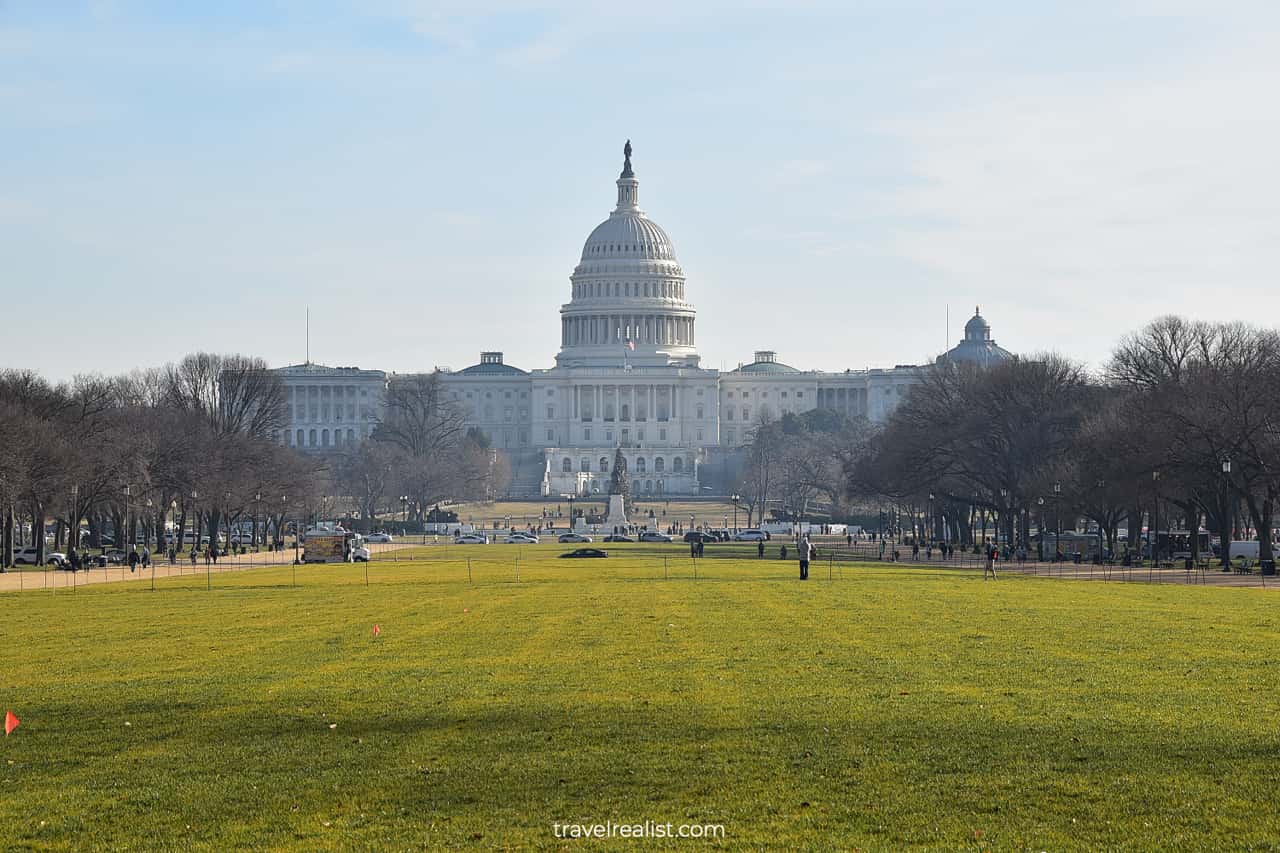
You could try getting a better look at the Capitol Reflecting Pool. Cars, people, fences, and scaffolding will likely be in your view. This viewpoint became less scenic after the events on January 6, 2021.
You could tour the U.S. Capitol Monday through Saturday. Join a free guided tour between 8:30 a.m. to 4:30 p.m. Since spots are limited, you might have to wait a while if you visit without a reservation.
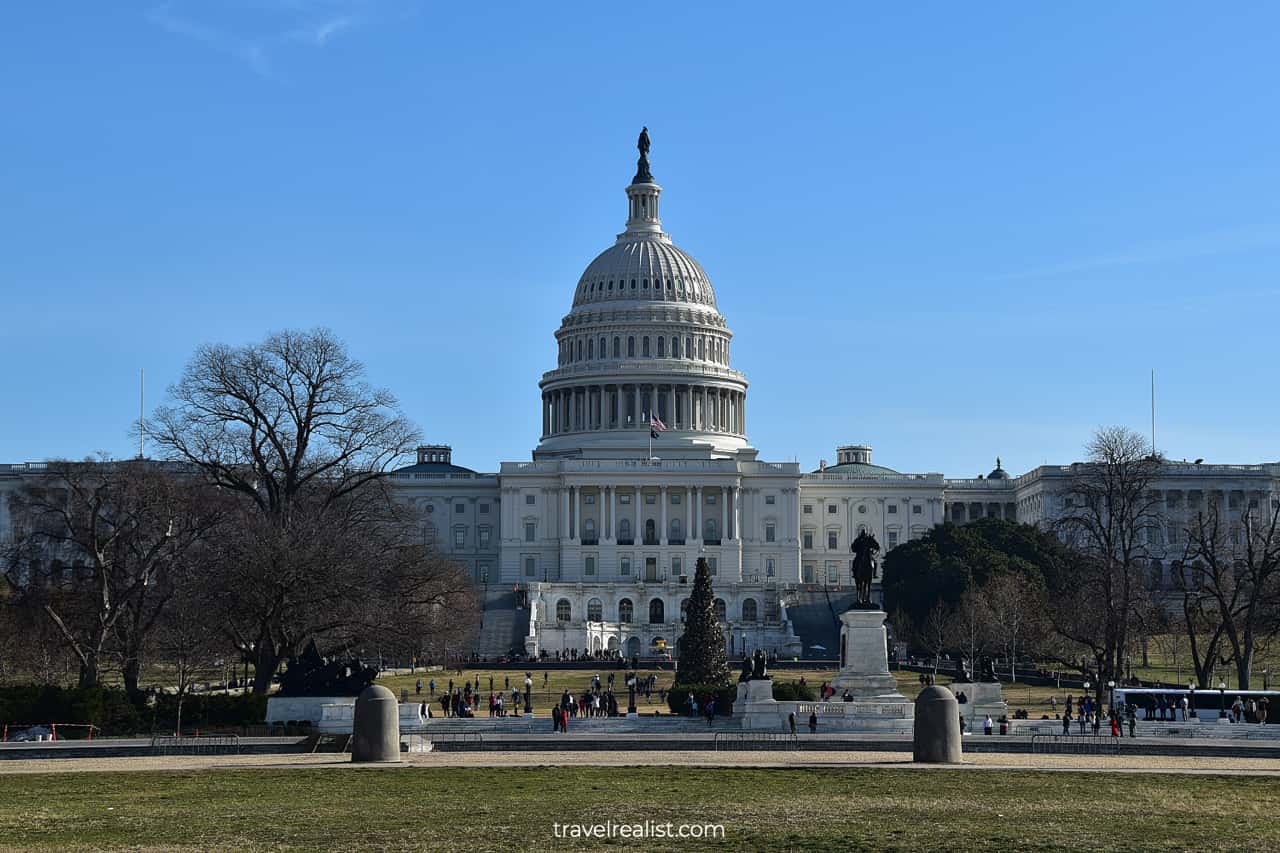
15. Supreme Court
There are a few nearby buildings that are not part of the National Mall. Yet, they are just a short walk from the United States Capitol. It would be a shame to not visit them during your National Mall trip.
The Supreme Court Building is one of them. The 1935 building is just a block east of the United States Capitol. You could reach this Neoclassical landmark in less than 5 minutes from the Capitol grounds.
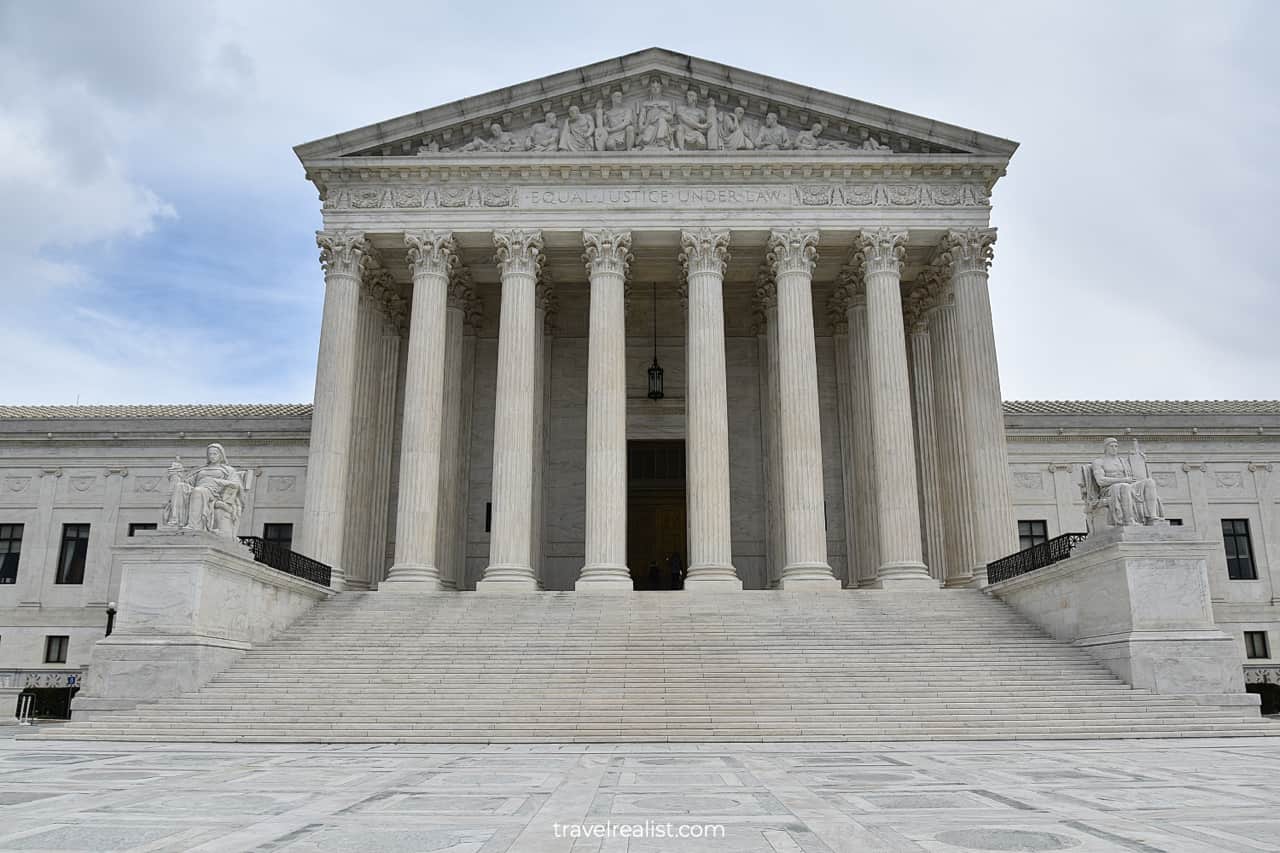
You could enter the Supreme Court from 9 a.m. to 4:30 p.m. Monday through Friday. The court is closed on the weekends and federal holidays. Enjoy a self-guided tour of the building without a reservation.
You should still come to the Supreme Court even if you visit the National Mall on a weekend. You could get a different look at the U.S. Capitol building from the steps of the Supreme Court.
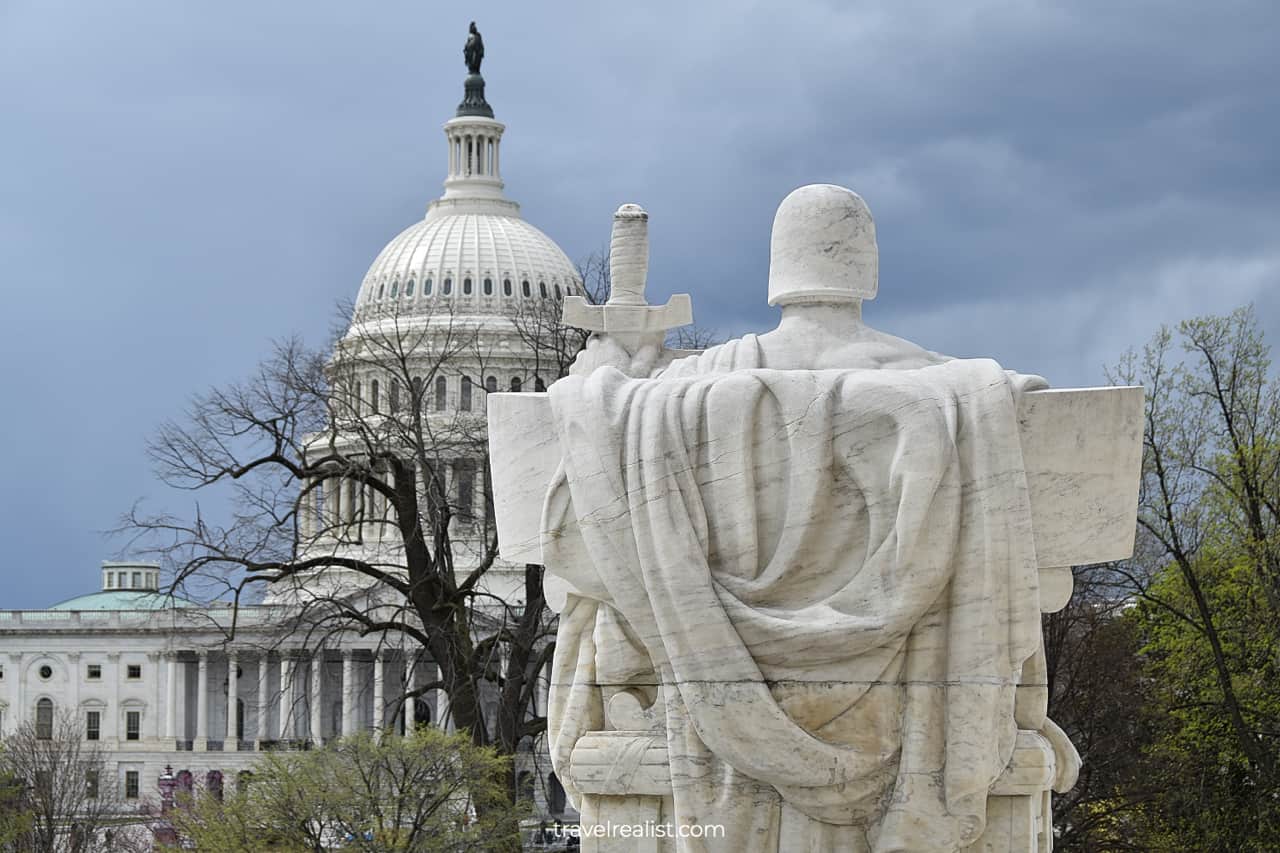
16. Library of Congress
The other building you should not miss is across East Capitol Street. The Thomas Jefferson Building of the Library of Congress dates back to 1897. You likely noticed its dome near the Washington Monument.
The Library has some of the most beautiful interiors in Washington, D.C. You are in luck since the building is open to the public. You could tour it between 10 a.m. and 5 p.m. from Tuesday to Saturday.
The Library of Congress is similar to the Washington Monument. While the visit is free, you need to get a timed reservation. It is available 30 days in advance or on the day of your visit. Spots are limited.
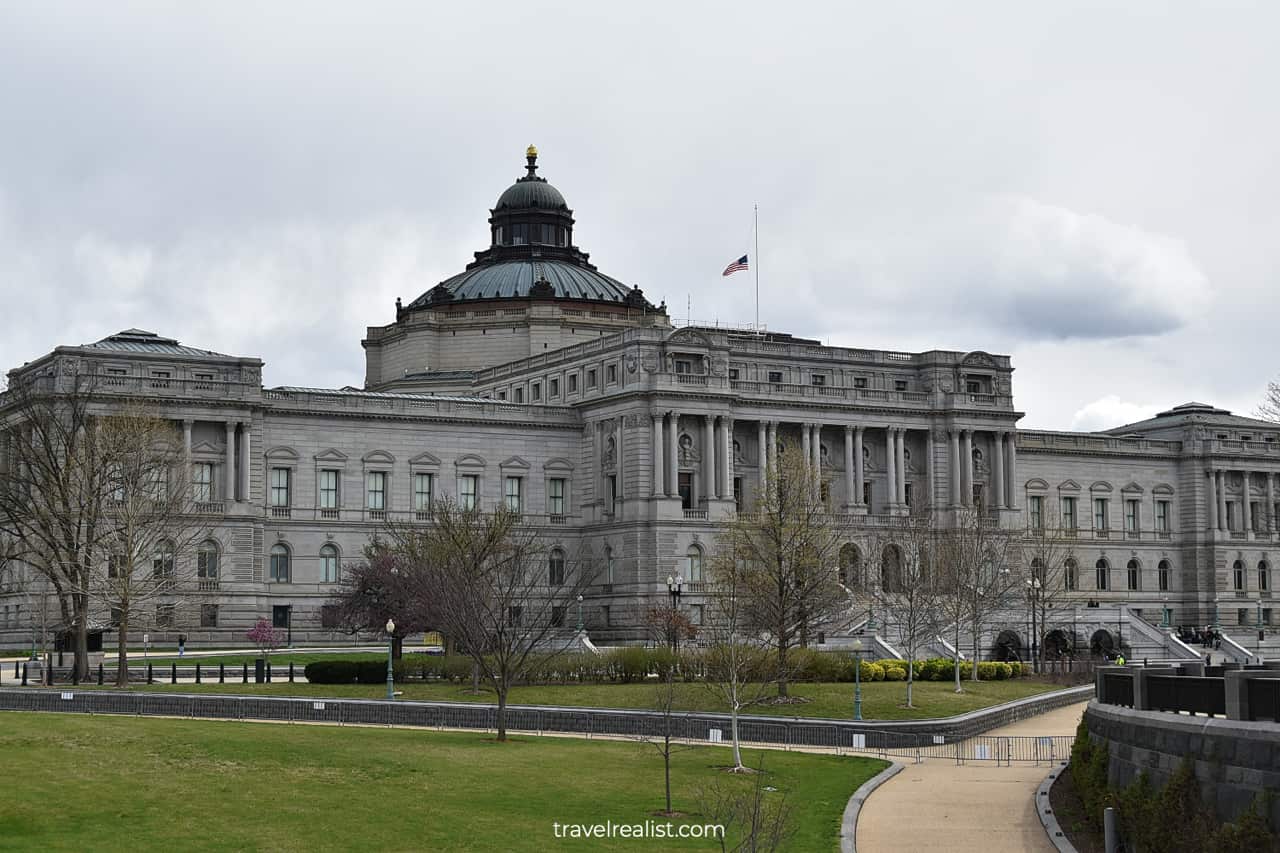
Continue with this National Mall Self Guided Walking Tour Guide. You will learn more about ways to get to the sights, entrance requirements, and places to stay.
Getting to National Mall
National Mall is a collection of sights in the center of Washington, D.C. When you search for the National Mall, Google Maps bring you to a location near Independence Avenue and Maine Avenue.
Therefore, it is better to enter individual attractions. This way, you will get an actual address. It will allow you to build an easy-to-follow walking route.
Metrorail is a good way to reach the National Mall. Smithsonian station is right at the Mall. Blue, Grey, and Orange line trains stop there. L’Enfant Plaza and Judiciary Square would work for other lines.
Subway brings you to the United States Capitol, White House, and Smithsonian Museums. But you need to walk to reach the Washington Monument and all Memorials.
It could be faster to take a Blue train to Arlington Cemetery and cross the Potomac River. Keep these distances in mind when planning a self guided walking tour of the National Mall.
You might not want to drive to the National Mall. Parking could be a nightmare in Washington, D.C. If you drive, book a spot in advance. This way, you could get parking for as low as $10 a day.
There are three airports in Washington Metropolitan Area. You could choose one that works best for you. Dulles (IAD) has the most connections. Baltimore-Washington (BWI) tends to have the lowest rates.
But neither can beat Ronald Reagan National (DCA) airport in proximity to the National Mall. You could be touring the National Mall in less than 30 minutes from this airport.
A subway ride is also cheapest from DCA. You will pay just $2 (weekend) or $2.35 (weekday). Compare it to $6 for IAD and around $11 for BWI on a weekday.
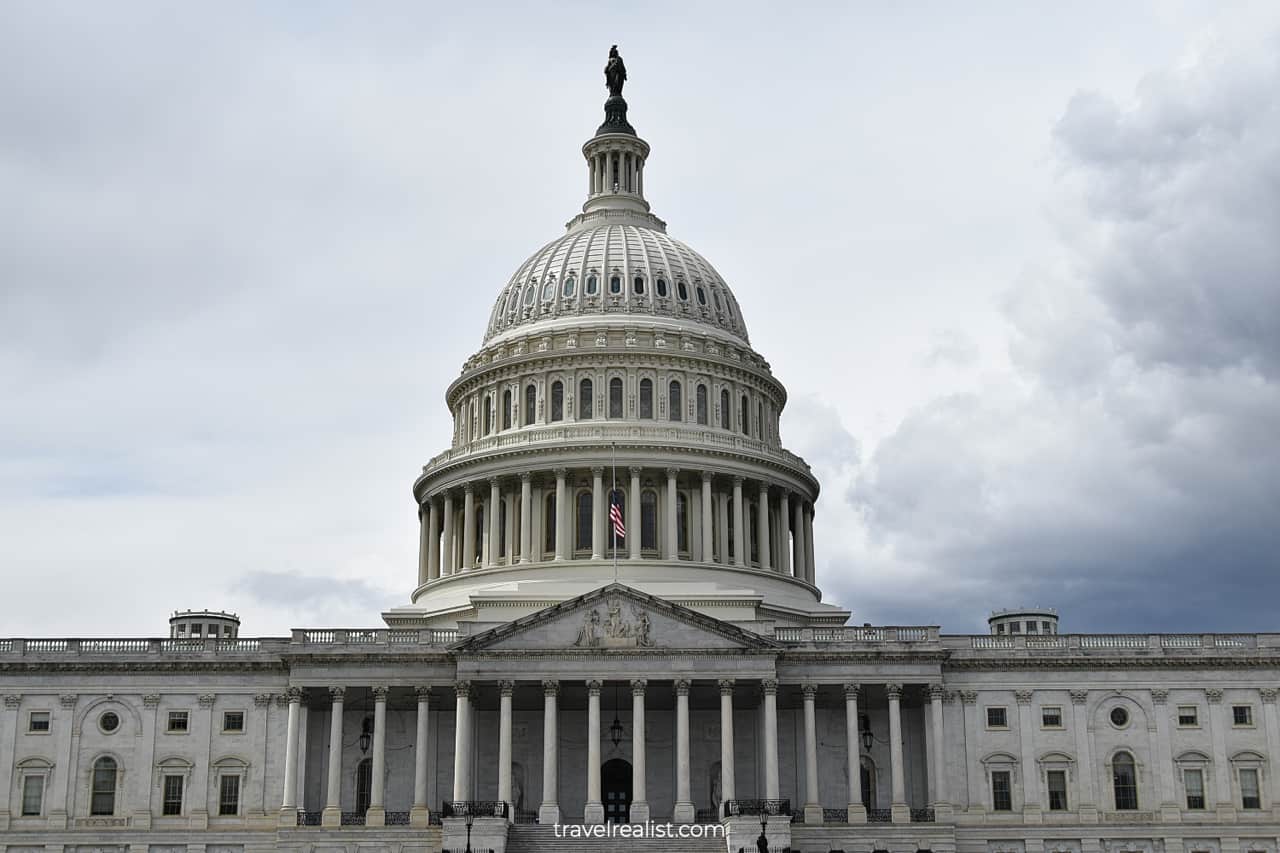
Where to Stay near National Mall
The National Mall is in the heart of Washington, D.C. There are a lot of places to stay next to the sights of the National Mall. But most hotels charge a premium for this location.
As a result, finding an affordable place to stay is far less easy. You need to book as far in advance as possible. Still, certain dates like federal holidays or Cherry Blossom season will be always expensive.
Check out Motto by Hilton Washington DC City Center and Washington Plaza Hotel. You could get to the National Mall from either hotel on foot or by subway.
Hotel Hive and State Plaza Hotel are also good places to stay. They are about equally close to the White House, Lincoln Memorial, and Farragut West station.
High prices for places to stay should not discourage you. You might be able to find a great deal if you are willing to stay further away from the sights.
You should not overlook Arlington, Virginia and Crystal City, Virginia. Both areas are across the Potomac River from the National Mall. On top of that, there are a handful of nice places to stay.
Check out Residence Inn Arlington Capital View and Homewood Suites By Hilton Arlington Rosslyn Key Bridge. These hotels are not the cheapest options. But they offer great value for money.
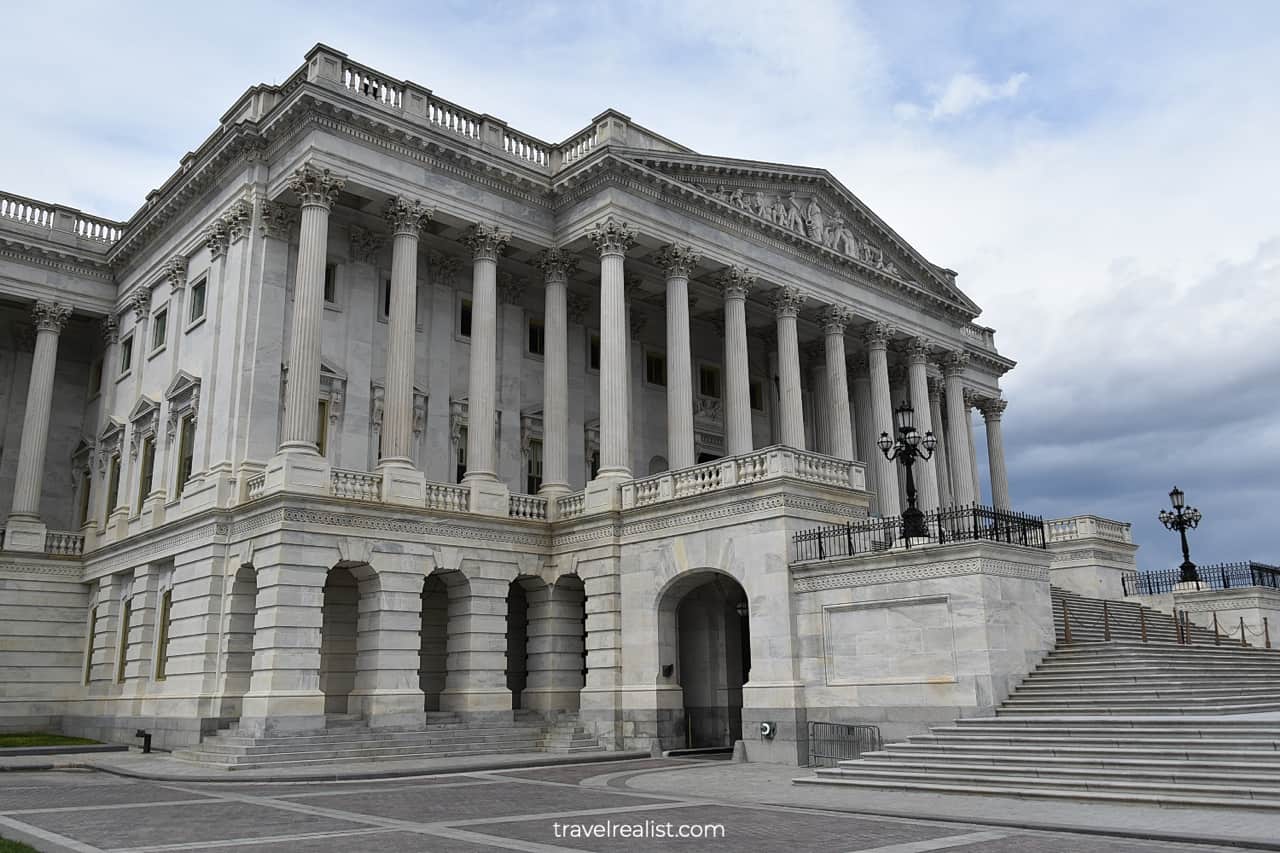
Entrance Requirements & Passes
The sights at the National Mall do not charge admission fees. You heard it right. You could visit some of the most famous landmarks in the United States without paying a penny.
There is no preparation to visit some sights. Just come and explore them as you please. Other sights require reservations. Still, you should not pay more than $1 per person per attraction in reservation fees.
The sights at the National Mall differ in their opening hours and requirements. This National Mall Self Guided Walking Tour Guide documents the main requirements by attraction.
- Thomas Jefferson Memorial: open 24 hours; free.
- Franklin Delano Roosevelt Memorial: open 24 hours; free.
- Martin Luther King, Jr. Memorial: open 24 hours; free.
- Lincoln Memorial: open 24 hours; free.
- World War II Memorial: open 24 hours; free.
- Washington Monument: open 9 a.m. to 5 p.m. 350 days a year; $1 for a timed reservation.
- White House: open for tours by arrangement from a member of Congress or embassy; free.
- Smithsonian Castle: closed for renovation; free when reopens.
- National Archives: open 10 a.m. to 5:30 p.m. daily; free. A $1 advance reservation is a good idea.
- National Gallery of Art: open 10 a.m. to 5 p.m. daily; free.
- United States Capitol: open 8:30 a.m. to 4:30 p.m. Monday to Saturday; free guided tour with a recommended reservation.
- Supreme Court: open 9 a.m. to 4:30 p.m. Monday to Friday; free for a self guided tour.
- Library of Congress: open 10 a.m. to 5 p.m. Tuesday to Saturday; free with a timed reservation.
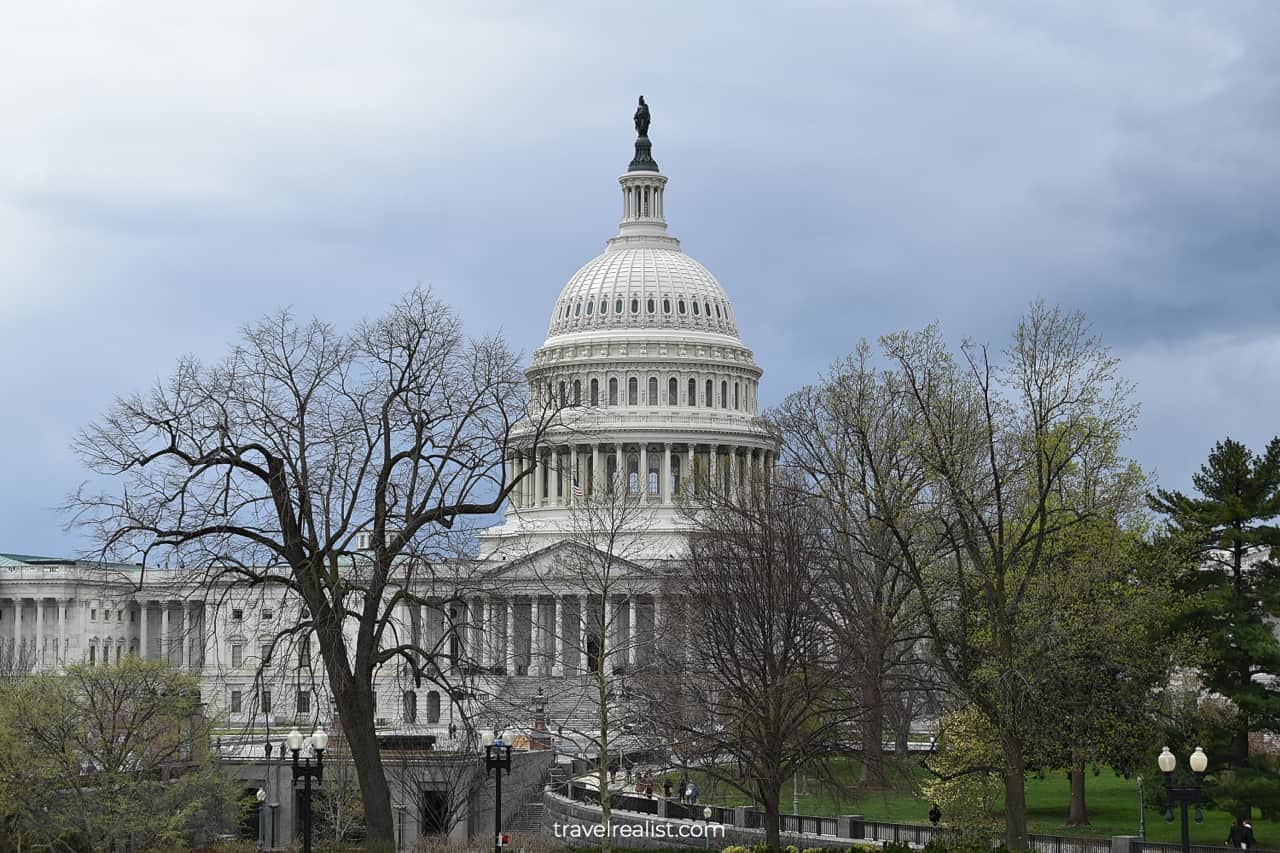
Takeaways: National Mall Self Guided Walking Tour
The National Mall is a must-visit destination for every traveler to Washington, D.C. There are few other places in the world with a comparable combination of history, architecture, arts, and science exhibits.
Its historic memorials and monuments are breathtaking. The museums and galleries are educational. The United States Capitol and the White House are the symbols of the country.
The National Mall is in a flat and walkable part of Washington, D.C. As a result, a self guided walking tour is the best way to see the National Mall.
All of the National Mall sights are open to the public for free. Only a handful of them require affordable advance or free same day reservations. It makes a visit to the National Mall a no-brainer decision.
But free admission is a double-edged sword. It brings a lot of people to the Mall. You will have to walk in a crowd and wait in line to enter a few sights. Same day reservations disappear minutes after posting.
There are a lot of places to visit at the National Mall already. Once you factor in crowds, there is no way to visit all sights in a day. You need to decide what sights at the National Mall to visit and to skip.
Pick a reasonable number of attractions. Get relevant reservations in advance. Secure parking ahead if time if you drive. And prepare for a long day full of walking and new memories.
Take a look at this National Mall Self Guided Walking Tour Video Guide. And visit the YouTube channel for the latest videos.
Frequently Asked Questions
You should budget at least 90 minutes to walk the National Mall.
– This time covers a walk from the Thomas Jefferson Memorial to the United States Capitol.
– You would need another hour to visit the memorials and take pictures.
– A visit to the Washington Monument, U.S. Capitol, National Archives, or any museum could add hours to your walk.
– The Lincoln Memorial is the westernmost attraction of the National Mall.
– The United States Capitol is at its eastern boundary.
– The Thomas Jefferson Memorial is a southernmost attraction.
– Lafayette Park and the White House are the most northern sights.
A walk around the National Mall takes about 4 miles (6 km). It includes a walk around the Tidal Basin and stops at the Lincoln Memorial and the U.S. Capitol.
The National Mall does not have designated parking. Book a parking spot in advance. There are a handful of garages in Penn Quarter neighborhood. You could find a spot for $10-$15 a day.
Parking garages near L’Enfant Plaza tend to be more expensive. But there are spots under $20 a day if you book early enough.
Smithsonian station is a Metrorail station at the National Mall. Grey, Blue, and Orange line trains stop there. L’Enfant Plaza is the closest stop on the Yellow and Green lines. Exit at Judiciary Square on the Red line.
A self guided walking tour is the best way to see the National Mall. Get your reservations in advance.
Safe realist travels!

